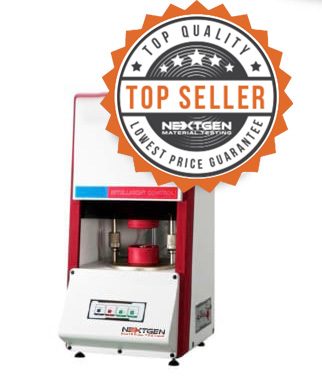
Rubber Testing Equipment

Standards
ASTM D5289, ISO 6502, DIN 53529






Description
The Moving Die Rheometer is a new development to the Oscillating Disc Rheometer solution. The unit meets ASTM D5289, ISO 6502, and DIN 53529. Repeatability also means your data is consistently reproducible from instrument to instrument and factory to factory, worldwide. Your data doesn’t shift just because your time zone does.
NextGen’s MDR is custom-designed and manufactured to withstand any continuous production environment. Offering robust durablility, repeatabily and most importantly a peace of mind. The NG-MDR Moving Die Rheometer is your solution for accurately assessing the curing and processing characteristics of vulcanized rubber compounds. Designed for precision, this state-of-the-art rheometer captures the characteristic curve and parameters of rubber vulcanization by measuring the torque applied to the oscillating die.
The NG-MDR rotor-free vulcameter stands out for its exceptional stability, delivering consistent and reliable results every time. Operating on a straightforward principle, the moving die rheometer works by placing a rubber compound sample in a sealed test cavity under positive pressure at an elevated temperature. A Rotor (oscillating disc) is embedded in the sample and oscillates through a small, specified rotary amplitude. This action applies a shear strain to the test piece, and the force (torque) required to oscillate the disc is directly related to the stiffness (shear modulus) of the rubber compound. Read more in our latest MEGA BLOG!
Moving Die Rheometer Functionality
- Database functionality can store your curves, drawings and results for printing at any time.
- Allows you to export your testing results in Excel format.
- It has multiple analysis functions like statistics, deviation setting, standard curve setting, and CPK statistical calculations
- Interface allows for local zoom and curve comparison
- It has such functions as selection of any vulcanization time, range selection and screen capture.
- It can reanalyze your previous test data, and increase or modify the reports according to the users requirements
- Multiple data sequences provide convenient ways for data retrieval
Features and Applications
- Rugged Construction: A durable machine frame designed to deliver the most stable readings, no matter the conditions.
- Sealed, Fanless Housing: The fanless and sealed design effectively prevents debris from infiltrating critical systems, ensuring long-lasting performance.
- Wearless Torque Drive: Equipped with the wearless direct torque drive motor, this machine offers unmatched precision and durability.
- Customizable Strain Modification: With software-programmable strain modification ranging from 0.01° to 5.0°, you can adapt the testing to your specific needs.
- Advanced Diagnostics: The NG-MDR includes internal diagnostic and condition monitoring routines, keeping your equipment in optimal condition.
- Optional Cooling Systems: For enhanced versatility, optional cooling systems are available to meet specific testing requirements.
Testing Curve and Results
- ML - Minimum torque (dNm) - Measures value of the vulcanization characteristic (viscosity) of the unvulcanised test sample
- MH - Maximum torque (dNm) - Measures value of the shear modulus or rigidity of the fully vulcanized test sample. This includes the maximum torque of the flat curve and titration curve as well as the maximum torque when the flat and titration curves don't appear within the given time.
- Ts1 (Minimum) - Time in which the torque is increased to ML + 1dNm when the swing angle is 0.5° or 1°
- Ts2 (Minimum) - Time in which the torque is increased to ML + 2dNm when the swing angle is 3°
- Ts10 (Minimum) - Time in which the torque is increased to ML + 10(MH-ML)/100dNm
- Ts30 (Minimum) - Time in which the torque is increased to ML + 30(MH-ML)/100dNm
- Ts60 (Minimum) - Time in which the torque is increased to ML + 60(MH-ML)/100dNm
- Ts90 (Minimum) - Time in which the torque is increased to ML + 90(MH-ML)/100dNm, reflecting the optimum vulcanization of your testing specimen
Moving Die Rheometer Standard Configurations
- Sealing rings: 10pcs
- Heating plate: 2pcs
- High temperature paper: 3 copies
- Desktop (PC): 1 set
- Printer: 1 set
- Hexagonal wrench: 1 set
Technical Specifications
| Temperature Range | Room Temperature to 22°C - 200°C |
| Temperature Accuracy | Within ±0.3°C |
| Temperature Display Resolution | 0.01°C |
| Oscillation Frequency | 1.6Hz, (100r/min) |
| Heating Rate | 120 °C / min |
| Torque Range | 0 - 20nm |
| Minimum Torque Reading | 0.001nm |
| # of Swing Angles | ± 0.5°C ± 1°C ± 2°C (standard matching angle 1 degree) |
| Swing Angle | 100r / min (1.66hz) |
| Control | Computer Controlled |
| Communication Mode | COM Port |
| Air Pressure | 65psi (4.6 bar) - Not including air compressor |
| Specimen Dimensions | 5cm |
| Display | NextGen Software |
| Dimension (W x D x H) | 51.5 x 22 x 24.5" 131 x 56 x 62cm |
| Weight | 498lbs / 226kg |
| Power | 110V/60Hz or 220V/50Hz 1000 W |
FAQs
The Moving Die Rheometer is primarily used to assess the curing behavior and processing characteristics of vulcanized rubber compounds. The test is essential for determining the material's response to heat and pressure during vulcanization. The device works by placing a rubber sample in a sealed cavity, where a die oscillates within the material under controlled conditions. The resistance (torque) applied by the material to the oscillating die is measured, providing insights into the rubber’s stiffness and curing properties.
The Moving Die Rheometer tracks critical parameters such as minimum and maximum torque, as well as specific vulcanization times (Ts1, Ts2, Ts90, etc.), which are vital for ensuring consistent product quality. This data helps manufacturers optimize the rubber curing process, making certain that materials meet the required standards for strength, flexibility, and durability. In the rubber industry, this is an instrument that is widely used for quality control, research, and development purposes.
Click here to learn more about the product or here to receive a personalized quote.
The Moving Die Rheometer (MDR) builds upon and improves the traditional Oscillating Disc Rheometer (ODR) by offering a more advanced and stable solution for testing the curing and processing characteristics of vulcanized rubber compounds. The key difference lies in the design: while the ODR relies on a rotor (oscillating disc) embedded in the rubber sample, the Moving Die Rheometer eliminates this rotor, making the system more precise and durable.
In both systems, the test sample is placed in a sealed cavity under pressure and maintained at an elevated temperature. In the traditional ODR, the oscillating disc applies shear strain to the test piece, and the torque required to oscillate the disc is measured, reflecting the material’s stiffness. However, the MDR's rotor-free design reduces mechanical wear and offers better torque measurement accuracy. This makes the MDR exceptionally stable, producing highly reproducible data across different environments and production settings.
Additionally, the Moving Die Rheometer enhances ease of use with robust functionality, including features like database storage for curves and results, exporting to Excel, statistical analysis, and customizable vulcanization time settings. These advanced features provide users with detailed insights into material performance.
Click here to learn more about the product or here to receive a personalized quote.
The Moving Die Rheometer complies with ASTM D5289, ISO 6502, and DIN 53529 standards. This compliance is a necessity as it guarantees that the device meets international benchmarks for assessing rubber compounds' curing and processing characteristics. Compliance with these standards means that the rheometer provides consistent and reliable results across different industries and laboratories worldwide.
For manufacturers and researchers, compliance with these standards is crucial for improving rubber products' quality and performance. Whether used in quality control or research and development, the MDR ensures test results are consistent with industry expectations and regulations. This level of compliance makes the Moving Die Rheometer a trusted tool in global rubber testing environments, guaranteeing that materials meet safety and performance specifications.
Click here to learn more about the product or here to receive a personalized quote.
The Moving Die Rheometer is designed with a high level of repeatability, meaning that data produced by the instrument is consistently reproducible from one machine to another, regardless of location or time zone. This repeatability helps to ensure that test results remain accurate and reliable across instruments and factories worldwide. Whether used in a research facility or production environment, the rheometer's ability to maintain consistent results is crucial for verifying the quality and performance of vulcanized rubber products.
This feature is especially helpful for global manufacturers, as it eliminates data discrepancies from environmental or geographical factors. The MDR makes certain that rubber testing results are not influenced by time zones or machine variations, providing peace of mind that the data is consistent, reliable, and globally comparable. This level of consistency helps maintain production standardization, leading to better quality control and product reliability.
Click here to learn more about the product or here to receive a personalized quote.
The NG-MDR rotor-free vulcameter stands out for its exceptional stability, consistently delivering reliable results in every testing condition. By eliminating the rotor used in traditional systems, this rheometer minimizes mechanical wear and tear, leading to greater long-term precision and reduced maintenance. The rotor-free design allows for more accurate torque measurements so that the data generated during rubber vulcanization testing is both stable and reproducible.
This stability is critical for industries that rely on precision in material testing, as it guarantees consistent results across different test runs and environments. Whether used in a laboratory or production facility, the NG-MDR provides users with confidence that their results will remain accurate and reliable over time, contributing to better quality control and material performance assessment.
Click here to learn more about the product or here to receive a personalized quote.
The Moving Die Rheometer operates on the principle designed to assess rubber compounds' curing characteristics. A rubber sample is placed in a sealed test cavity, which is subjected to positive pressure and maintained at an elevated temperature. Inside this cavity, a rotor (oscillating disc) is embedded in the sample. The disc oscillates at a small, specified rotary amplitude, applying shear strain to the rubber compound.
The key measurement in this process is the torque (force) required to oscillate the disc, which is directly related to the stiffness (shear modulus) of the rubber compound. As the sample undergoes vulcanization, the rheometer measures how the stiffness changes, providing critical data about the curing process. This method provides accurate tracking of the material’s behavior under heat and pressure, helping manufacturers fine-tune rubber formulations for desired performance characteristics.
Click here to learn more about the product or here to receive a personalized quote.
Yes, the Moving Die Rheometer complies with ASTM D5289, a standard test method for measuring rubber curing characteristics using a rotorless cure meter. This standard outlines the procedures for evaluating the vulcanization process by measuring the torque applied to a rubber sample during oscillation. ASTM D5289 is specifically designed to assess important properties such as cure time, scorch time, and the material’s stiffness (shear modulus) during the vulcanization process.
The Moving Die Rheometer adheres to this standard by providing accurate measurements of the torque required to oscillate the die within the rubber sample, giving insights into the rubber’s behavior as it cures under heat and pressure. The data captured during the test helps manufacturers verify that their rubber compounds meet specifications for flexibility, durability, and performance. Compliance with ASTM D5289 guarantees that the results produced by the Moving Die Rheometer are consistent, reliable, and valid for quality control, research, and development purposes across the rubber industry.
Click here to learn more about the product or here to receive a personalized quote.
Yes, the Moving Die Rheometer complies with ISO 6502, an international standard that outlines methods for determining the cure characteristics of rubber compounds through oscillating rheometers, such as the Moving Die Rheometer. ISO 6502 provides guidelines for measuring critical parameters like torque, curing time, and material stiffness during vulcanization. The standard provides assurance that the equipment used delivers accurate and repeatable results.
Compliance with ISO 6502 means that the Moving Die Rheometer follows a globally recognized testing protocol, making it suitable for evaluating rubber compounds' vulcanization behavior in a standardized manner. By meeting this standard, the Rheometer provides reliable data on curing processes, which is crucial for quality control, research, and material development.
Click here to learn more about the product or here to receive a personalized quote.
Yes, the Moving Die Rheometer complies with DIN 53529, a German standard that specifies testing procedures for assessing rubber compounds' curing behavior. This standard outlines how to measure key parameters such as torque, curing time, and rubber stiffness during the vulcanization process. The DIN 53529 standard is widely used in the rubber industry to ensure that test results are accurate and reliable.
By complying with DIN 53529, the Moving Die Rheometer guarantees that it delivers precise and repeatable data, particularly regarding rubber mechanical properties during curing. This adherence to the standard allows for consistent quality control and product development across different testing environments. DIN 53529 compliance means that manufacturers using the MDR can trust the results for their rubber compounds, whether for research, development, or production purposes, guaranteeing that the material meets industry performance and safety requirements.
Click here to learn more about the product or here to receive a personalized quote.
The Moving Die Rheometer offers comprehensive database functionality that allows users to store important test data, including curves, drawings, and results. This capability makes certain that all testing data is readily available for printing or further analysis at any time. Users can access stored information efficiently, making it easier to review past test results, compare outcomes, and generate reports when needed.
The stored data can be reanalyzed and used for generating customized reports according to specific user requirements. This feature enhances workflow by reducing manual record-keeping and providing convenient data retrieval for quality control or research purposes. Furthermore, the system supports exporting test results to formats like Excel, making data integration and further statistical analysis more streamlined and accessible.
Click here to learn more about the product or here to receive a personalized quote.
Yes, the Moving Die Rheometer allows users to export testing results in Excel format. This feature makes it convenient for users to further analyze and manipulate the data as needed for additional reporting, statistical evaluations, or comparisons. Exporting to Excel allows compatibility with widely used software, enabling seamless integration of the data into broader quality control systems or research databases. It is especially useful for labs and manufacturers who require a great deal of flexibility in the way they handle and present test results, allowing for easier collaboration and sharing across teams when handling test results.
Click here to learn more about the product or here to receive a personalized quote.
The Moving Die Rheometer offers multiple advanced analysis functions, including statistical analysis, deviation setting, standard curve setting, and CPK (Capability Process Index) statistical calculations. These features allow users to perform in-depth analyses of test data directly within the system. The statistical tools help evaluate the performance and consistency of the material being tested, while deviation settings allow for additional customization in setting tolerance limits for quality control.
The standard curve setting provides users with the ability to compare test results against predefined benchmarks, providing assurance that the rubber compound meets the required specifications. CPK calculations help monitor process capability, making sure that the manufacturing process is within the desired performance range.
Click here to learn more about the product or here to receive a personalized quote.
The Moving Die Rheometer interface offers advanced features such as local zoom and curve comparison. These capabilities allow users to closely examine specific sections of their test data by zooming into particular areas of the curves for detailed analysis. The curve comparison feature enables users to overlay multiple test curves to compare results, helping to identify trends or discrepancies across different tests.
This functionality is especially useful for quality control and research, as it allows for a more granular examination of the curing process and material performance. By enabling side-by-side comparison and precise zoom, the interface allows for easier data interpretation, making it simpler to pinpoint variations and verify that rubber compounds meet the necessary specifications. These tools provide a more user-friendly and efficient way to analyze test outcomes without additional software.
Click here to learn more about the product or here to receive a personalized quote.
The Moving Die Rheometer is equipped with several advanced features, including the ability to select any vulcanization time, range selection, and screen capture. These functions provide flexibility in test conduct and analysis. The selection of vulcanization time allows users to customize and control the specific time frame for each test, making certain that the curing process is monitored according to their precise requirements.
Range selection lets users define specific parameters or thresholds for their tests, which enhances control and accuracy during rubber compound analysis. Additionally, the screen capture feature enables users to take snapshots of data or curves directly from the interface, making it easy to document and share results without relying on external tools. These functions improve the overall usability and efficiency of the testing process.
Click here to learn more about the product or here to receive a personalized quote.
Yes, the Moving Die Rheometer can reanalyze previous test data and modify reports according to the user’s specific requirements. This feature allows users to revisit their stored data and apply new analysis techniques or adjust settings based on evolving testing needs. By enabling reanalysis, the rheometer ensures that users can gain further insights from past results without repeating tests.
Additionally, the system provides flexibility in generating reports, allowing modifications to the format and content of reports as needed. This helps in creating customized documentation that aligns with specific projects or client demands. Whether for quality control, research, or detailed comparisons, this functionality guarantees that users have the tools to adapt their analysis and reporting to meet various requirements.
Click here to learn more about the product or here to receive a personalized quote.
The Moving Die Rheometer offers multiple data sequences that provide users with flexible and convenient ways to retrieve stored information. This functionality allows easy access to past test results, enabling quick and efficient data retrieval for analysis or reporting. Users can organize and access their data by various criteria so that they can locate specific results without manual searches.
This feature is particularly useful for labs and manufacturers that need to review multiple tests over time. It simplifies workflow by offering organized access to historical data, which can be used for comparisons, reanalysis, or report generation. The ability to handle multiple data sequences makes the Moving Die Rheometer a powerful tool for maintaining a comprehensive and accessible database of rubber testing results.
Click here to learn more about the product or here to receive a personalized quote.
The Moving Die Rheometer is built with a durable machine frame designed to provide the most stable and accurate readings, regardless of testing conditions. This rugged construction guarantees that the machine can withstand continuous use in demanding production environments, minimizing the impact of external vibrations or environmental changes on the testing process.
By maintaining structural stability, the Moving Die Rheometer consistently delivers precise and reliable data during vulcanization. The strong, robust frame protects the internal components from wear and tear, extending the machine's lifespan and providing accuracy. This durable design makes the Moving Die Rheometer a dependable choice for labs and manufacturers who require long-term stability and reliability in rubber testing.
Click here to learn more about the product or here to receive a personalized quote.
The sealed, fanless housing of the Moving Die Rheometer prevents debris, dust, and other particles from entering the critical components of the machine. This protection ensures that the internal systems remain clean and free from contamination, which is crucial for maintaining test results' precision and accuracy. The fanless design eliminates airflow, reducing debris infiltration risk and resulting in a longer-lasting, more reliable performance in harsh environments.
By avoiding fans, the system also reduces noise and mechanical wear, contributing to quieter, low-maintenance operation. This sealed, fanless design is especially valuable in industrial or lab settings where environmental factors impact sensitive testing equipment.
Click here to learn more about the product or here to receive a personalized quote.
How does the wearless torque drive in the Moving Die Rheometer improve its precision and durability?
This Moving Die Rheometer is equipped with a wearless direct torque drive motor, which significantly improves the precision and durability of the device. This advanced motor design eliminates mechanical wear commonly associated with traditional torque drive systems, resulting in consistent and highly accurate torque measurements throughout the testing process. The system maintains accuracy over time without degradation of performance due to the removal of components that are prone to wear, such as belts and gears.
The wearless design of the machine increases long-term durability and reduces the need for frequent maintenance, helping the machine to perform optimally in challenging production environments. As a result, even after extensive use, the Moving Die Rheometer will continue to deliver precise and accurate data for rubber vulcanization tests for a long time to come.
Click here to learn more about the product or here to receive a personalized quote.
Yes, the Moving Die Rheometer allows for customizable strain modification with software-programmable settings that range from 0.01° to 5.0°. This feature enables users to tailor the testing parameters to their specific requirements, providing flexibility in how strain is applied during the vulcanization testing process. By adjusting the strain modification, users can simulate different real-world conditions and evaluate the rubber compound’s performance under different strain levels.
This customization is particularly useful for research, product development, and quality control, where precise adjustments are necessary to meet unique testing goals or material specifications. Whether you need to test small or large deformations, the programmable strain modification feature allows the Moving Die Rheometer to adapt easily to diverse testing scenarios, resulting in accurate and relevant results for a wide range of applications.
Click here to learn more about the product or here to receive a personalized quote.
Yes, the Moving Die Rheometer (NG-MDR) is equipped with advanced diagnostics and condition monitoring routines that help maintain the equipment in optimal condition. These internal diagnostic systems continuously monitor the machine's performance, so that any issues or inefficiencies are detected early. This proactive approach helps prevent unexpected breakdowns and guarantees consistent and accurate operation over time.
The condition monitoring routines also provide real-time feedback on the machine's health, allowing users to address potential maintenance needs before they affect the accuracy or reliability of test results. This advanced diagnostic capability is crucial in laboratories and production environments where continuous, high-quality performance is essential, minimizing downtime and guaranteeing that the machine is always ready for precise rubber testing.
Click here to learn more about the product or here to receive a personalized quote.
Yes, the Moving Die Rheometer offers optional cooling systems to increase versatility and meet specific testing requirements. These cooling systems allow users to control the temperature during testing, which is essential for evaluating rubber compounds' behavior under various thermal conditions. By integrating cooling systems, the rheometer can simulate a broad range of real-world scenarios, including rapid temperature changes or maintaining low temperatures during vulcanization testing.
This optional feature is particularly beneficial for manufacturers and researchers who need precise temperature management to meet the specific needs of different rubber compounds. The ability to regulate cooling helps guarantee that material performance is accurately assessed, especially in applications where temperature sensitivity is a critical factor. These cooling systems enhance the overall functionality and adaptability of the Moving Die Rheometer.
Click here to learn more about the product or here to receive a personalized quote.
The Moving Die Rheometer provides detailed testing curves and results critical for analyzing rubber compounds' vulcanization process. These curves help measure specific torque values and times, which correspond to various stages of vulcanization:
-
ML (Minimum Torque): This measures the viscosity or flow characteristics of the unvulcanized rubber sample, indicating how easily the material can deform before curing.
-
MH (Maximum Torque): This represents the shear modulus or rigidity of the fully vulcanized rubber sample, showing the stiffness after curing is complete. As well as the maximum torque of flat and titration curves, it covers even when these curves don't appear within the expected time frame.
-
Ts1, Ts2, Ts10, Ts30, Ts60, Ts90 (Minimum Times): These reflect the incremental increases in torque (ML) over time, showing how quickly the rubber cures. For example, Ts1 is the time required for the torque to increase by 1 dNm over ML, while Ts90 represents the time when the torque reaches 90% of the difference between ML and MH, indicating optimal vulcanization.
Click here to learn more about the product or here to receive a personalized quote.
The Moving Die Rheometer comes with standard configurations to ensure optimal operation and testing flexibility. These include:
-
Sealing rings (10 pcs): Used to maintain airtight conditions within the test cavity, maintaining pressure and temperature control.
-
Heating plate (2 pcs): These plates are critical for controlling and maintaining elevated temperatures required for vulcanization testing.
-
High-temperature paper (3 copies): This paper is used in high-temperature testing environments to provide accurate measurements without affecting the sample or equipment.
-
Desktop (PC - 1 set): A desktop computer is provided for running the software and managing test data, allowing smooth control over testing operations.
-
Printer (1 set): The included printer allows immediate printouts of test results, facilitating easy documentation.
-
Hexagonal wrench (1 set): A hex wrench is supplied for maintenance and adjustments so that the equipment can be quickly tuned as needed
Click here to learn more about the product or here to receive a personalized quote.
The Moving Die Rheometer operates within a temperature range from room temperature to 22°C – 200°C. This extensive range of temperatures is crucial for accurately assessing the vulcanization process of rubber compounds. Rubber curing requires specific temperature conditions to induce chemical changes. The ability to maintain such a precise temperature range allows the material’s behavior, particularly its mechanical properties like stiffness, strength, and elasticity, to be monitored accurately throughout the curing process.
This temperature control is particularly important for quality control and research in industries that rely on rubber materials, such as automotive, aerospace, and manufacturing. By simulating the heat conditions rubber materials will experience during actual use, the Moving Die Rheometer allows manufacturers to optimize formulations, making certain that their products meet durability and performance standards under various thermal conditions.
Click here to learn more about the product or here to receive a personalized quote.
The Moving Die Rheometer offers a temperature accuracy of 0.3°C. This high level of precision is necessary for maintaining consistent and reliable test conditions during rubber compound vulcanization. Even slight deviations in temperature can impact the curing process, leading to variations in the material's mechanical properties such as stiffness, strength, and elasticity. By guaranteeing that the temperature remains within a tight tolerance, the rheometer provides more accurate and reproducible test results.
This precise temperature control is particularly important in industries, where material performance must meet strict standards. Whether used in research or quality control, the ability to maintain such accuracy ensures that rubber compounds are tested under consistent thermal conditions, leading to better predictions of how the material will perform in real-world applications. The ±0.3°C accuracy increases the reliability of the rheometer's data.
Click here to learn more about the product or here to receive a personalized quote.
The Moving Die Rheometer features a temperature display resolution of 0.01°C, meaning it can measure and display temperature changes with a high degree of precision. This fine resolution is crucial in rubber vulcanization testing, where even the smallest variations in temperature can significantly affect the curing process and the final properties of the rubber, such as elasticity, stiffness, and durability.
The ability to monitor temperature changes to the nearest 0.01°C allows for greater control and guarantees that test conditions are as accurate and consistent as possible. This precision helps manufacturers and researchers fine-tune their testing protocols, leading to more reliable data for assessing rubber compounds' performance and quality under controlled thermal conditions. The high resolution makes certain that critical temperature fluctuations are detected, providing confidence in the material testing process and assuring that the material meets industry standards.
Click here to learn more about the product or here to receive a personalized quote.
The Moving Die Rheometer operates at an oscillation frequency of 1.6Hz, equivalent to 100 revolutions per minute (r/min). This frequency is significant because it directly impacts the shear strain applied to the rubber sample during testing. The consistent oscillation of the die allows for precise measurements of the material’s stiffness (shear modulus) as the rubber undergoes vulcanization.
By maintaining a steady oscillation frequency, the rheometer guarantees that the rubber compound is tested under controlled and repeatable conditions. This frequency is optimal for assessing how the material responds to mechanical strain, providing valuable data on the curing behavior and processing characteristics of rubber. The oscillation frequency plays a crucial role in ensuring the accuracy and reliability of test results, which are a crucial element for quality control, research, and development in the rubber manufacturing industry.
Click here to learn more about the product or here to receive a personalized quote.
The Moving Die Rheometer has a heating rate of 120°C per minute, which allows for rapid temperature adjustments during vulcanization testing. This fast heating rate is crucial for assuring that the rubber sample reaches the desired testing temperature quickly, minimizing the time needed to stabilize the sample under heat. It simplifies the testing process by reducing waiting periods and increasing overall testing efficiency.
A rapid heating rate also ensures that the rubber compound undergoes consistent thermal exposure, which is essential for an accurate assessment of its curing behavior. By heating the material at a controlled and fast pace, the rheometer makes certain that temperature-related variables do not interfere with the results, providing reliable data on rubber vulcanization characteristics. This is particularly beneficial in industrial settings where high-throughput testing is necessary.
Click here to learn more about the product or here to receive a personalized quote.
The Moving Die Rheometer features a torque range of 0 - 20Nm, which is ideal for measuring the resistance (torque) applied to the rubber sample during the vulcanization process. This torque range allows the rheometer to evaluate both the minimum and maximum torque values, providing a comprehensive understanding of the material's stiffness and mechanical properties as it transitions from an unvulcanized to a fully cured state.
By covering this torque range, the rheometer can accurately assess the viscosity, shear modulus, and overall rigidity of the rubber compound. These measurements are critical for determining the curing characteristics of the material, making certain that it meets the desired performance specifications for various applications. The broad torque range also enables the testing of a broad range of rubber compounds, making the Moving Die Rheometer a versatile tool for both research and quality control in the rubber industry.
Click here to learn more about the product or here to receive a personalized quote.
The Moving Die Rheometer has a minimum torque reading of 0.001Nm, which is highly helpful for providing precise measurements of the torque applied to the rubber sample during testing. This high level of sensitivity allows the rheometer to detect even the smallest changes in the material's stiffness, especially during the early stages of vulcanization when the rubber is soft and less resistant to deformation.
Accurate minimum torque readings are crucial for understanding the initial viscosity of unvulcanized rubber and for tracking how it cures under heat and pressure. This precision ensures that manufacturers and researchers can closely monitor the curing process, making it easier to optimize rubber formulations and ensure consistent product quality. The 0.001Nm sensitivity enables the rheometer to capture detailed data on a wide range of rubber compounds.
Click here to learn more about the product or here to receive a personalized quote.
The Moving Die Rheometer offers swing angles of ±0.5°C, ±1°C, and ±2°C, with the standard matching angle being 1 degree. These swing angles refer to the range within which the oscillating die moves during testing, applying varying levels of shear strain to the rubber sample. The ability to choose between different swing angles allows for greater flexibility in testing, as it enables the rheometer to simulate different real-world strain conditions that rubber compounds may encounter.
This flexibility is important for accurately evaluating the material's behavior under different strain levels so that the curing process is assessed comprehensively. By offering multiple swing angles, the Moving Die Rheometer provides detailed insights into how different rubber formulations respond to mechanical stress. This allows for better optimization of the material’s properties for specific applications.
Click here to learn more about the product or here to receive a personalized quote.
The Moving Die Rheometer operates with a swing angle of 100 revolutions per minute (r/min), or 1.66Hz. This swing angle refers to the frequency at which the die oscillates during the testing process, applying shear strain to the rubber sample. The oscillation is crucial for measuring the torque response of rubber as it undergoes vulcanization, which helps determine the material's stiffness (shear modulus) and curing characteristics.
The frequency of 100 r/min (1.66Hz) guarantees that the strain is applied consistently and accurately throughout the test, allowing for precise measurements of the rubber's behavior during the vulcanization process. This consistent swing angle is essential for ensuring repeatable and reliable data, which is critical for quality control and material development in the rubber industry. The specific swing angle settings allow for flexibility in adapting the test conditions to match different rubber formulations.
Click here to learn more about the product or here to receive a personalized quote.
The Moving Die Rheometer is computer-controlled, meaning that all testing processes, data management, and adjustments are managed via dedicated software. This computer control system allows for precise testing parameter configuration, such as temperature, torque, and swing angle. The user-friendly software interface provides a streamlined way to set up, monitor, and analyze tests, making it easier to manage complex testing sequences.
In addition to controlling the instrument, the software also handles data storage, analysis, and reporting, allowing users to efficiently retrieve and export test results for further review. This level of automation ensures consistency in testing conditions and reduces human error, making the Moving Die Rheometer an ideal tool for both research and quality control in rubber testing.
Click here to learn more about the product or here to receive a personalized quote.
The Moving Die Rheometer utilizes a COM port (serial communication port) for its communication mode. This type of communication is necessary for establishing a stable and reliable connection between the Rheometer and the computer that controls it. The COM port ensures seamless and uninterrupted data transfer, allowing for accurate and real-time control of testing parameters such as temperature, torque, and timing.
Using a COM port also increases compatibility with different operating systems and laboratory setups, making it easier for users to integrate the rheometer into their existing testing environment. The straightforward and dependable nature of COM port communication guarantees that the test data is transmitted efficiently, which is vital for maintaining accuracy and reliability in both research and quality control applications.
Click here to learn more about the product or here to receive a personalized quote.
The Moving Die Rheometer requires an air pressure of 65 psi (4.6 bar) to operate effectively, though it does not include an air compressor. This air pressure is necessary to maintain the sealed test environment within the rheometer during testing so that the rubber sample is subjected to the correct pressure conditions throughout the vulcanization process.
Proper air pressure is crucial for obtaining accurate and consistent test results, as deviations in pressure could affect the mechanical properties of the rubber being tested. Maintaining stable air pressure allows the instrument to simulate real-world conditions more effectively, providing reliable data for quality control, research, and product development in the rubber industry. Users will need an external air compressor to supply the required pressure.
Click here to learn more about the product or here to receive a personalized quote.
The Moving Die Rheometer is designed to accept rubber specimens with dimensions of 5 cm. This standard specimen size guarantees that the sample fits securely within the sealed test cavity, allowing the machine to perform accurate and consistent testing. Proper specimen dimensions are essential for maintaining uniform pressure and temperature during the test, which directly impacts the quality of the torque and curing data collected.
Using the correct specimen size is important for achieving reliable results, as it guarantees that the rubber material is subjected to the same conditions throughout the testing process. Consistent specimen dimensions help eliminate variability in testing, making the results more reproducible and comparable between different tests or production batches. This is critical for both research and quality control applications in the rubber industry.
Click here to learn more about the product or here to receive a personalized quote.
The Moving Die Rheometer is equipped with a NextGen Software display. This software interface provides a user-friendly, intuitive platform for controlling the rheometer and monitoring the test process in real-time. The NextGen Software allows users to easily set testing parameters, track data as it is collected, and manage various testing sequences with precision.
Additionally, the software supports data visualization, enabling users to view critical information such as torque curves and vulcanization times directly on the screen. The clear and organized display makes it possible for users to interpret results quickly, while built-in features like local zoom and curve comparison further enhance the analysis process. Overall, the NextGen Software-powered display improves the efficiency and accuracy of the rubber testing process, making it easier for users to manage tests and evaluate results.
Click here to learn more about the product or here to receive a personalized quote.
The Moving Die Rheometer has dimensions of 51.5 x 22 x 24.5 inches (equivalent to 131 x 56 x 62 cm). These dimensions are crucial for understanding the physical footprint of the machine, and making sure that users have adequate space for installation in their laboratories or production facilities. The compact design allows for efficient use of space while maintaining robust construction for precise rubber testing.
The machine's size is balanced to accommodate the necessary components, including the test chamber, temperature controls, and software interface, without taking up excessive room. Understanding the dimensions also helps in planning for any additional equipment, such as an air compressor or cooling systems, needed alongside the rheometer. This allows for optimal performance and ease of integration into existing workflows.
Click here to learn more about the product or here to receive a personalized quote.
The Moving Die Rheometer weighs 498 lbs (226 kg). This substantial weight reflects the robust construction of the machine, which is necessary for maintaining stability during testing. The heavy frame minimizes vibrations and external influences, ensuring that the testing environment remains consistent and that accurate torque and temperature measurements are recorded without interference.
The weight also contributes to the machine’s durability, allowing it to withstand continuous use in industrial settings without compromising performance. For laboratories or production facilities, understanding the weight is important for planning the installation and assuring that appropriate support and space are available for the machine. The sturdy build guarantees reliable operation over time, making the Moving Die Rheometer a dependable tool for precise rubber testing in both research and production environments.
Click here to learn more about the product or here to receive a personalized quote.
The Moving Die Rheometer operates with power requirements of 110V/60Hz or 220V/50Hz, with a power consumption of 1000 watts. This dual voltage capability makes it possible for the rheometer to be used in a variety of regions around the world, as it accommodates both North American (110V) and European (220V) power standards. The flexibility in power settings makes the equipment suitable for use in different industrial and laboratory environments globally.
The 1000W power consumption ensures that the rheometer delivers the necessary energy to maintain precise control over its operations, including heating, oscillation, and data processing. Understanding the power requirements is crucial for achieving a proper setup in a facility, including compatibility with the available electrical infrastructure and maintaining efficient operation without overloading circuits. This power specification also highlights the machine’s capability to handle rigorous and continuous testing demands.
Click here to learn more about the product or here to receive a personalized quote.
Related Products
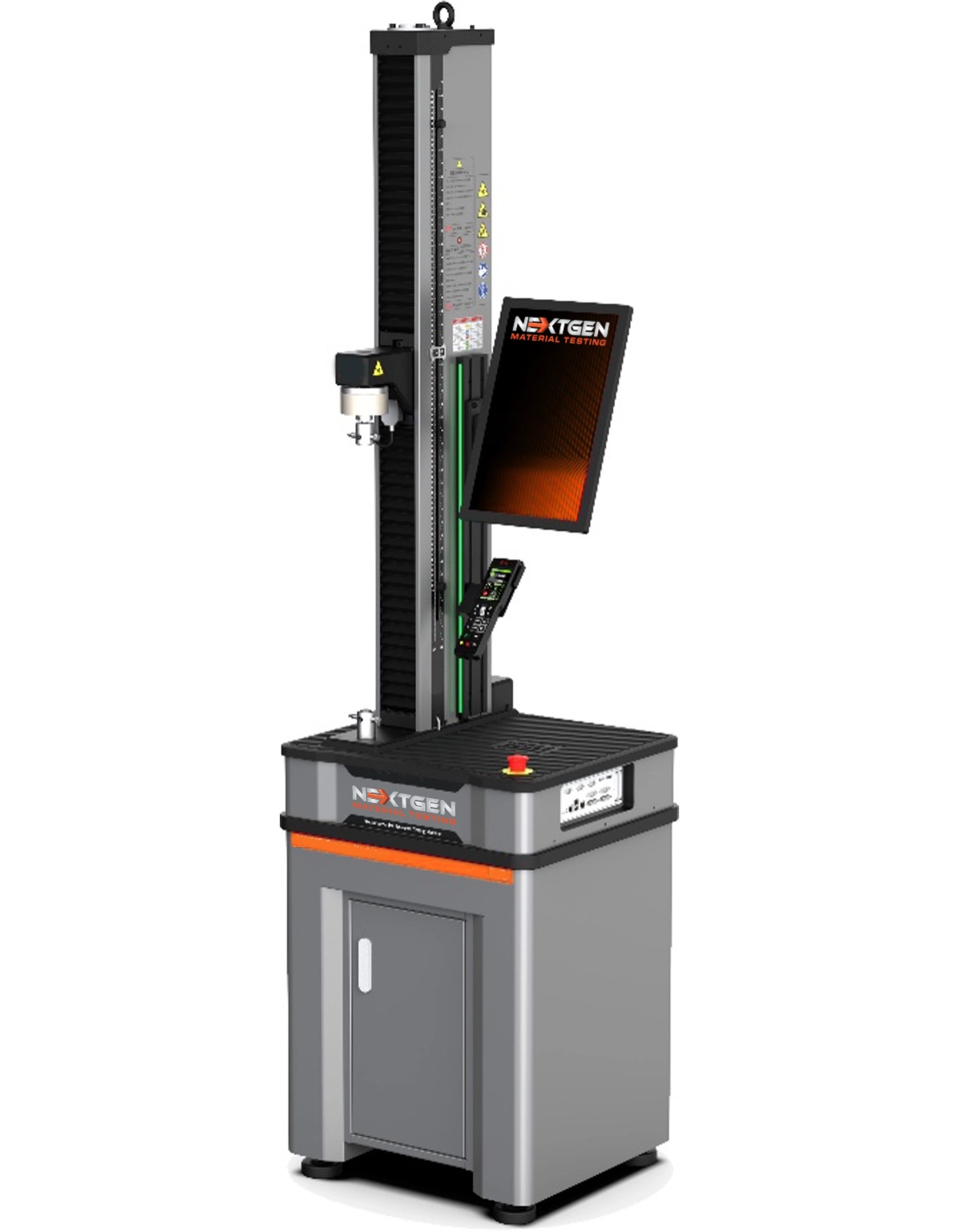
NG-EML Series A – Single Column Bench Top Universal Testing Machine (50 N – 5 kN)
The NG-EML Series A – Single Column Bench Top UTM (50 N–5 kN) is a precision electromechanical system designed for tension, compression, and flexural testing of low-force specimens. Featuring GenTest™ software, a high-speed servo drive, Class 0.5 accuracy, and USB/Ethernet control, this compact tabletop unit supports ASTM, ISO, and EN standards. Ideal for testing plastics, rubber, foams, films, composites, and thin metals.
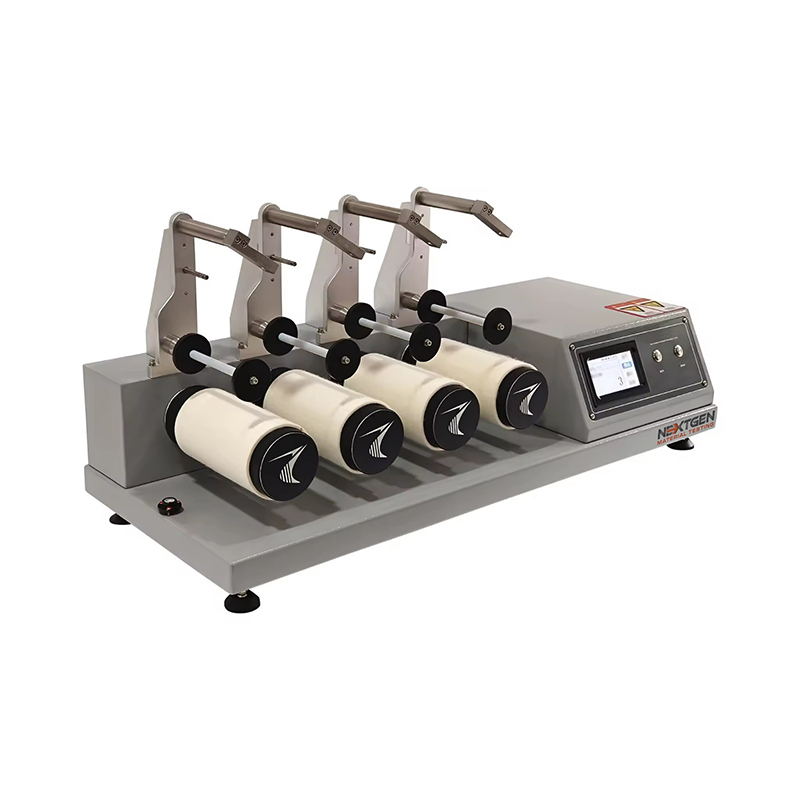
ICI / Mace Snag Tester
Discover the Fabric Textile ICI / Mace Snag Tester, a reliable tool for assessing fabric snagging under normal wear conditions.
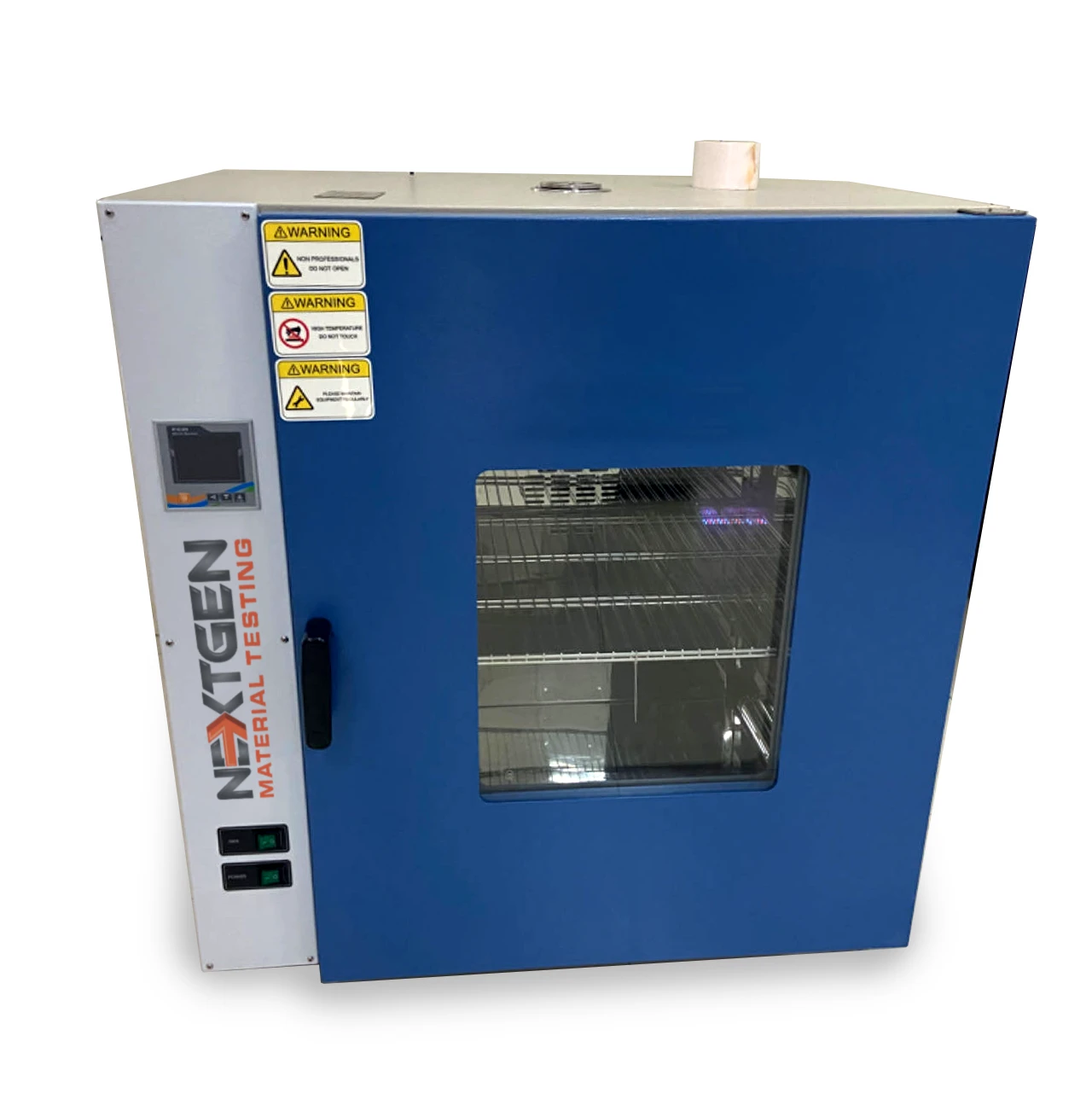
Aging Oven – High-Temperature Chamber – NG-AGOV-ADV
The NG-AGOV-ADV Aging Oven is designed for high-temperature testing of rubber, plastics, and insulating materials. It features programmable PID control, uniform airflow, and forced convection for stable and repeatable aging cycles. This system supports global testing standards including ISO 188, ASTM D573, and IEC 60216-4-1. With its durable stainless-steel chamber and user-friendly interface, it’s ideal for R&D, quality control, and certification labs.
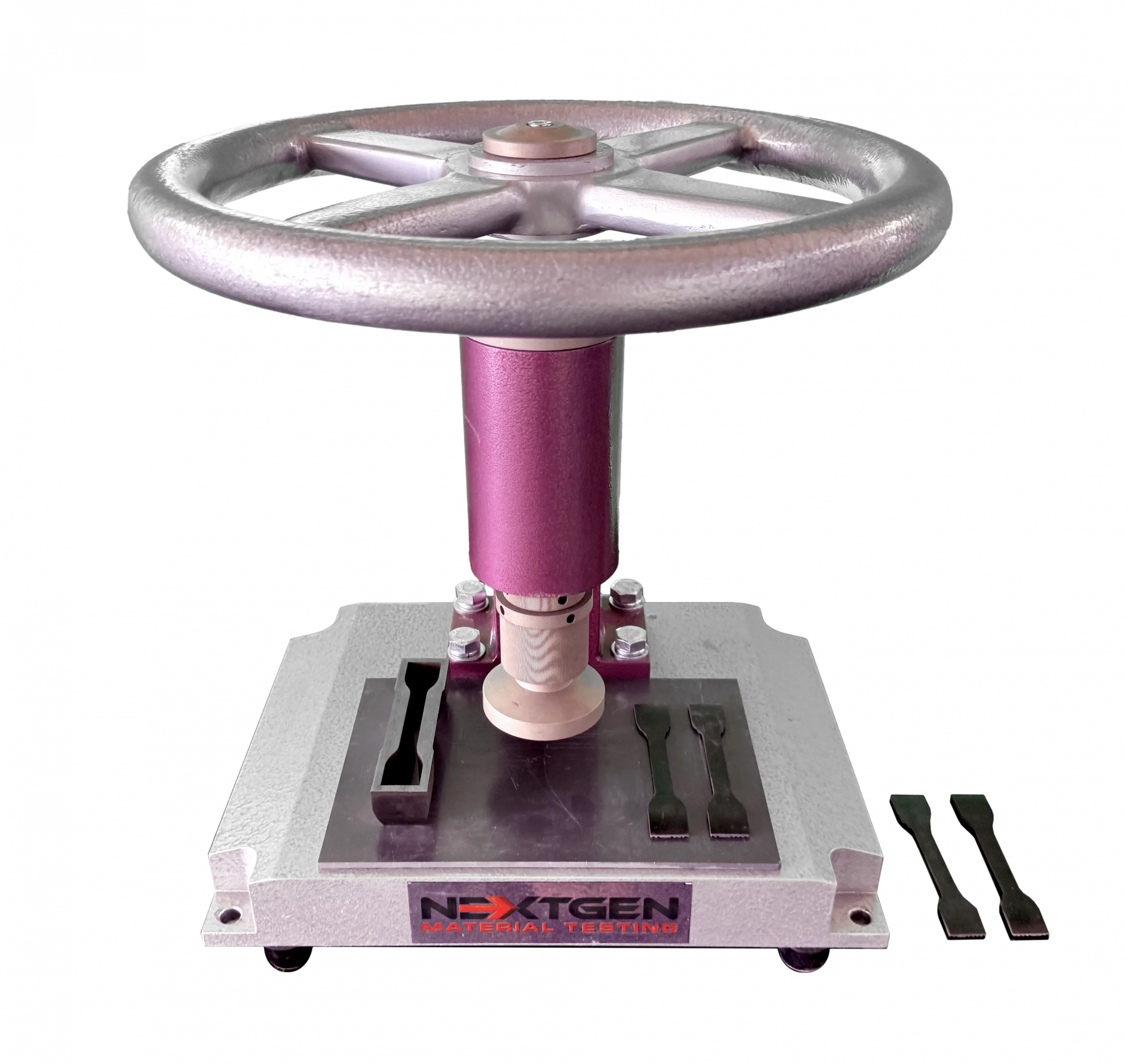
NG-T-Press M Series - Manual Cutting Press System for Rubber Tensile Specimens
Our newest manual cutting press system is suitable for laboratories to create specimens from rubber, tape, and special materials.
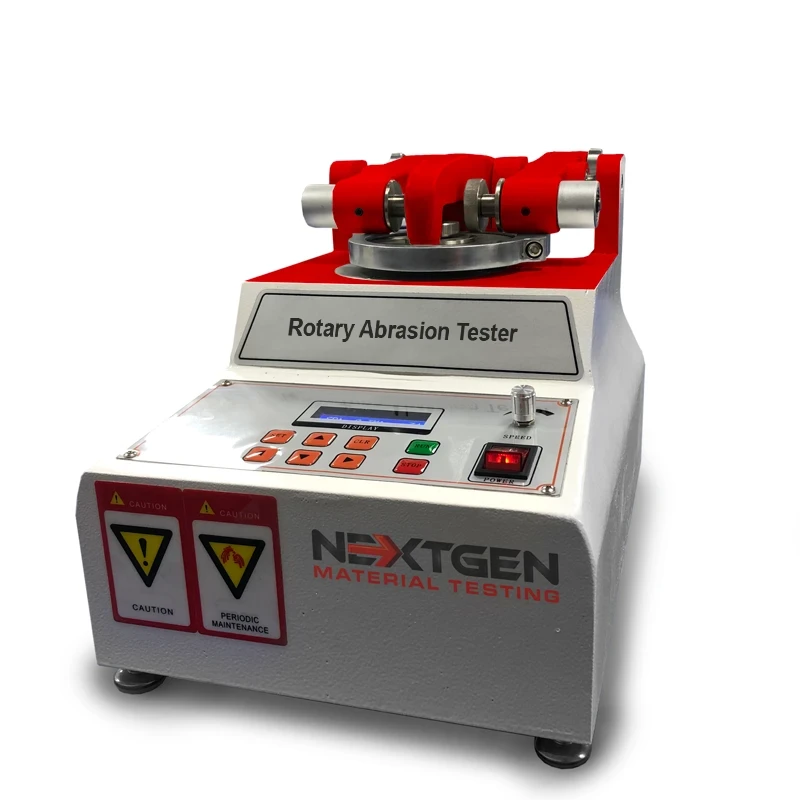
Rotary Abrasion Tester Single & Dual Wheel
GenRotary used evaluate abrasion resistance. It can conduct tests on a wide range of materials such as: cloth, paper, paint, plywood, leather, tile, glass, rubber etc. It tests the specimen by rotating it while in contact with the grinding wheel and applying the required pressure. The Joss of weight reflects on the change in weight of the specimen. The unit also has an intelligent power failure recovery function.
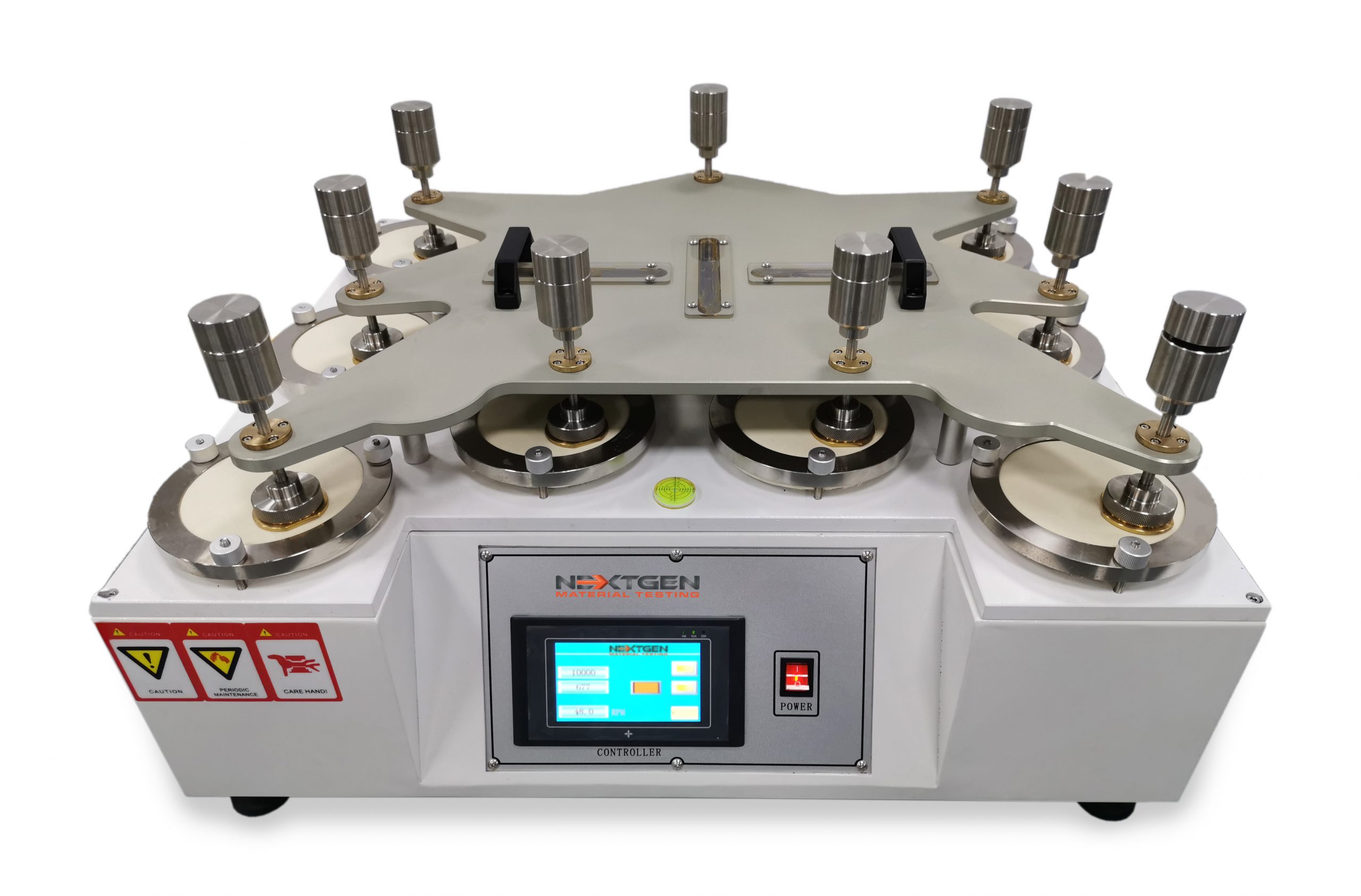
9-Station Martindale Abrasion Tester
The GenDale - Martindale Abrasion Tester is mainly used to test shoe fabric, shoe lining, and many other types of shoe related materials.
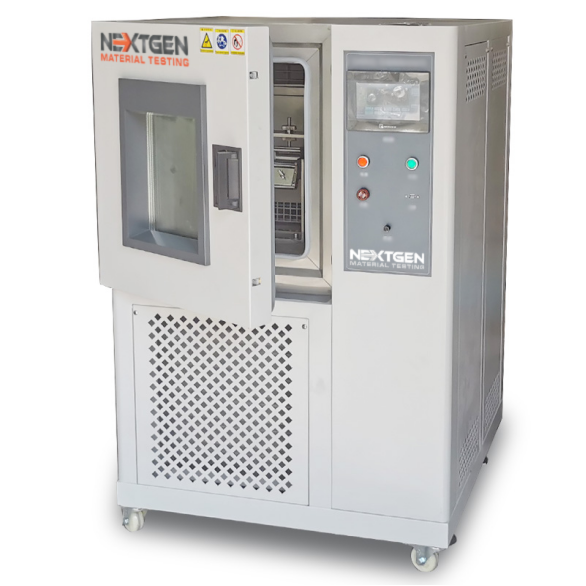
GenRoss-CH - Ross Flex Tester with Low Temperature Chamber
GenRoss-CH is an advanced Ross Flex Tester designed for assessing the cold resistance of materials in low temperature environments.

Linear Abrasion Tester
NextGen's linear abrasion meters evaluate the abrasion and scratch resistance of products, along with color transmission.
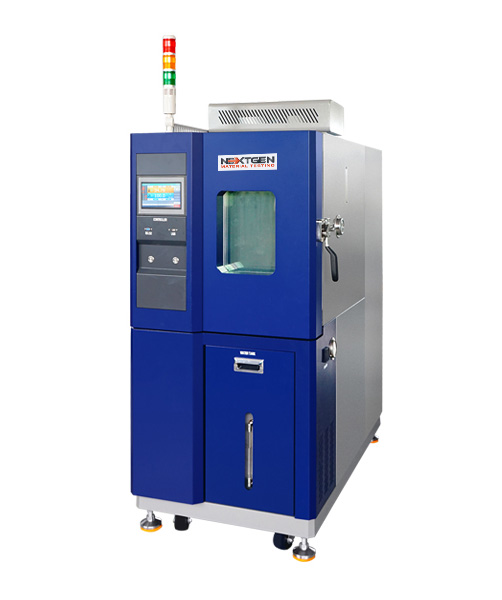
NextGen Environmental Chambers NG-EC 100,150,225,408,1000
The temperature and humidity NextGen Environmental Chambers features a sturdy cabinet made of cold-rolled steel and stainless steel.
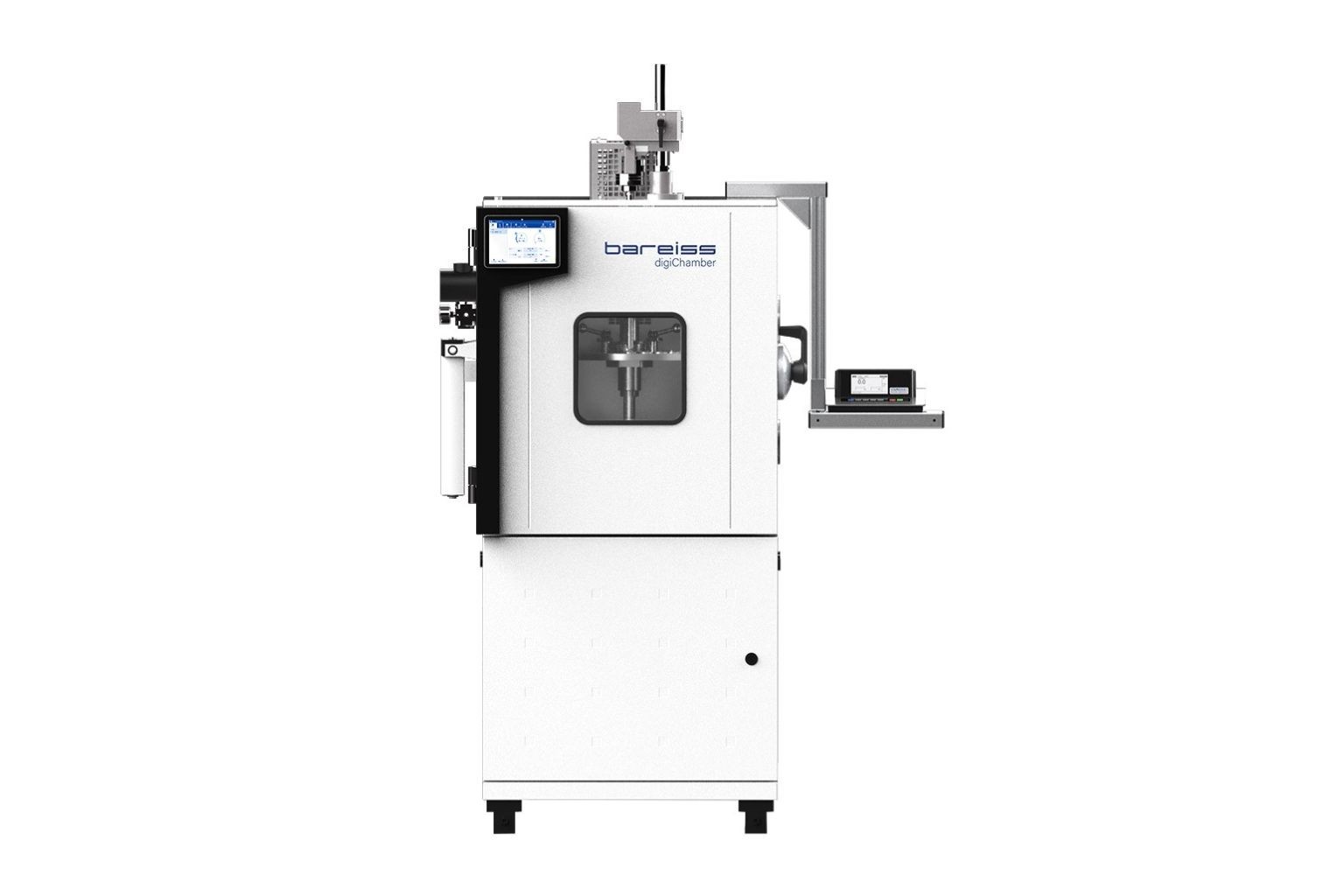
digiChamber - Temperature Controlled Hardness Testing
Discover digiChamber from NextGen Material Testing, the advanced temperature-controlled hardness tester developed by Bareiss.
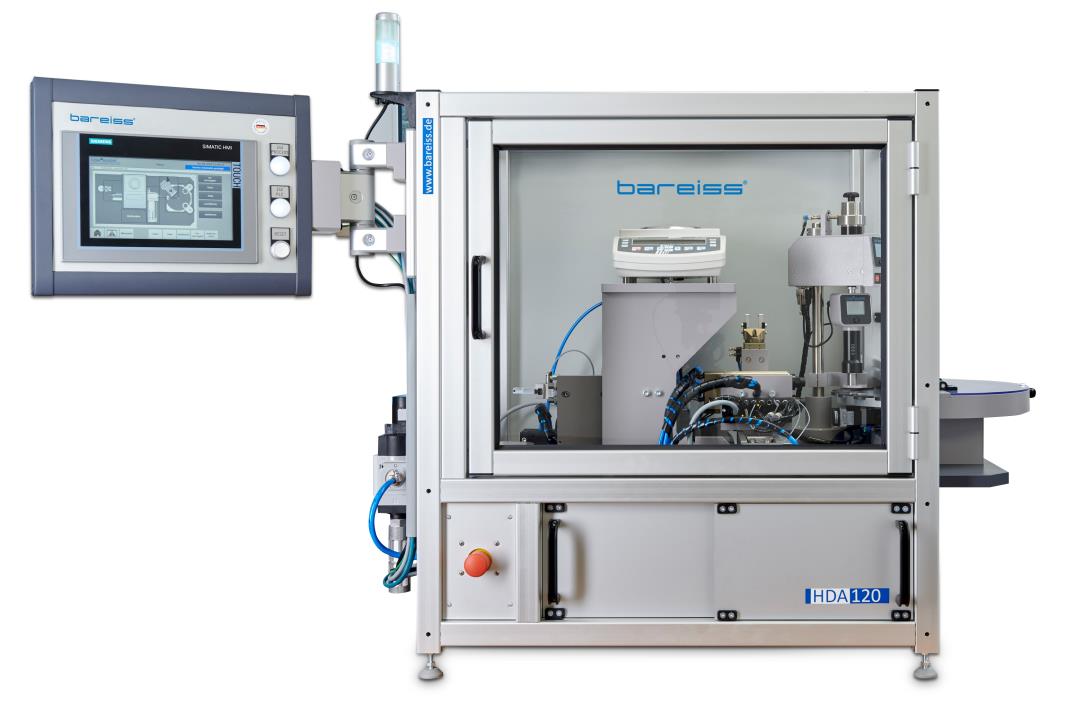
HDA 120 - Hardness and Density Automation Test System
The HDA 120 test system is a versatile solution for semi-automatic detection of sample hardness and density.
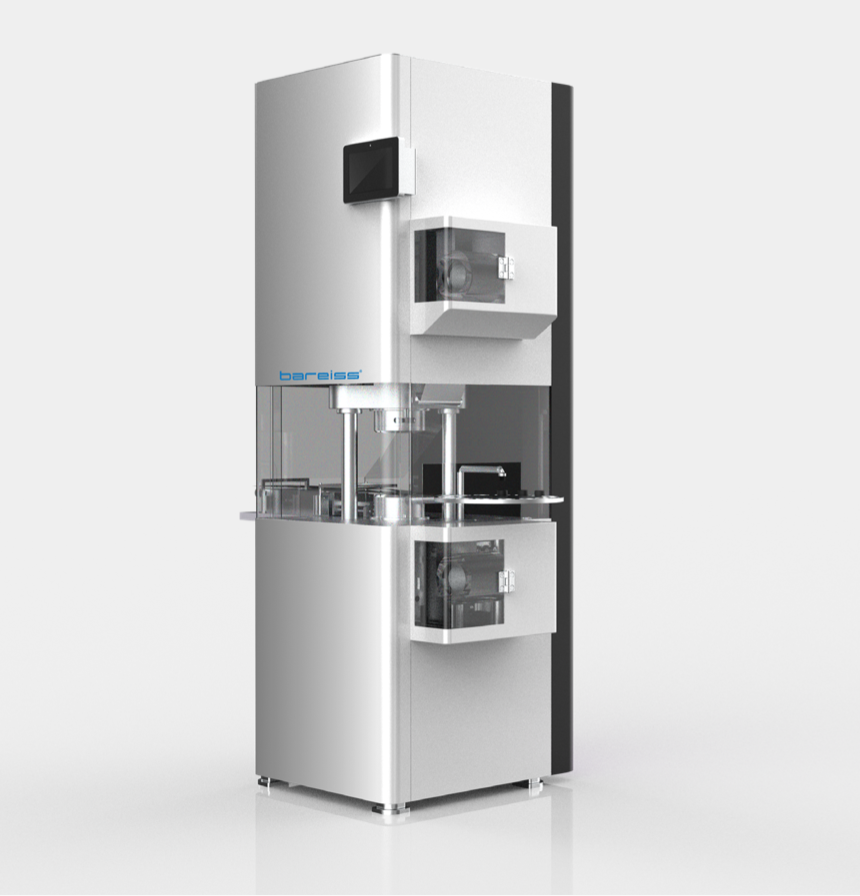
RPA Ultra - Advanced Rubber Process Analyzer Rheometer
RPA Ultra is an advanced rubber process analyzer rheometer that measures the dynamic and static characteristics of raw rubber compounds
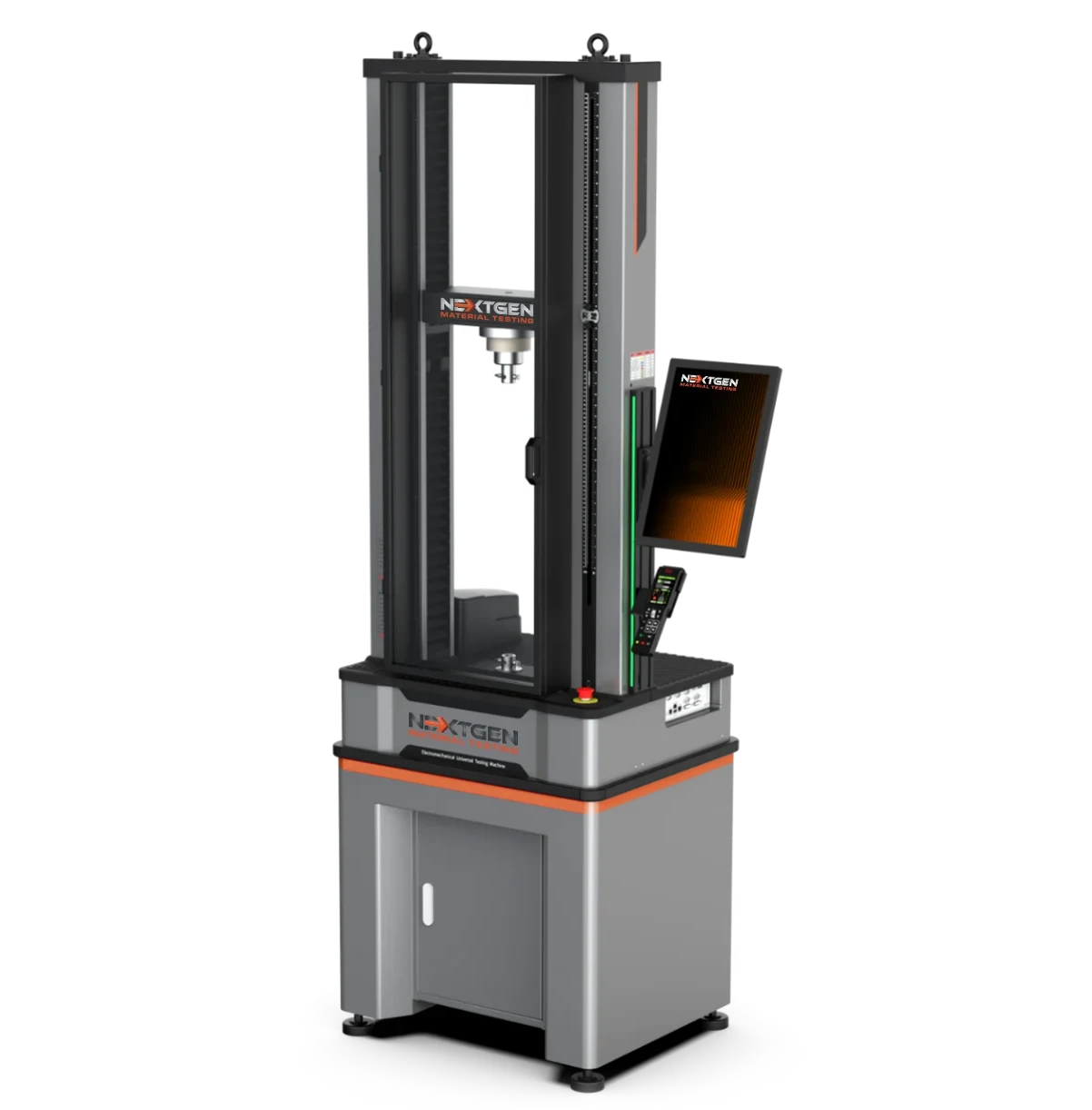
NG-EML Series B – Dual Column Bench Top Universal Testing Machine (100 N – 10 kN)
The NG-EML Series B is a high-precision dual-column benchtop universal testing machine engineered for tensile, compression, and flexural testing in the 0.1 kN to 10 kN range. It features Class 0.5 accuracy, a rigid FEM-optimized frame, and a direct-drive servo system with advanced closed-loop control, making it ideal for testing rubber, plastics, metals, composites, and high-performance polymers in both R&D and quality assurance settings.
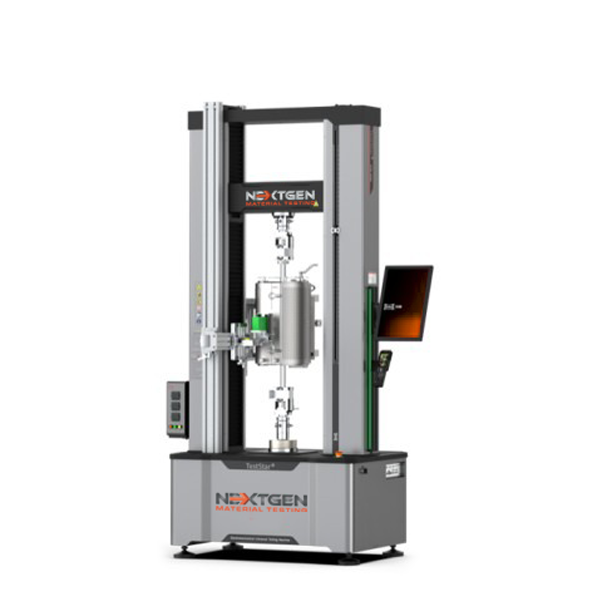
NG-EML Series C – Dual Column Bench Top and Floor Standing Universal Testing Machine (5 kN – 50 kN)
The NG-EML Series C is a precision-engineered dual-column universal testing machine for tension, compression, and flexural testing of metals, composites, rubbers, and polymers. Available in both bench-top and floor-standing formats, with force capacities from 5 kN to 50 kN and Class 0.5 accuracy.
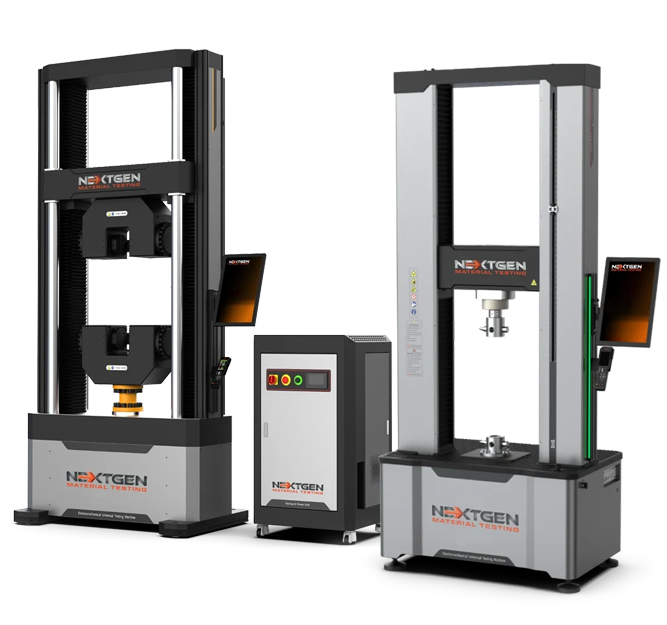
NG-EML Series D – Floor Standing Universal Testing Machine (50 kN – 1000 kN)
The NG-EML Series D – Floor Standing Universal Testing Machine (50 kN–1000 kN) is a dual-column system for tensile, compression, flexural, shear, and cyclic testing of high-strength metals, composites, polymers, and advanced materials. Available in single-space and dual-space configurations, it meets ASTM E8, ISO 6892-1, ISO 527, and GB/T 228 standards. With closed-loop control, 1200 Hz sampling, ultra-low speeds (0.00005 mm/min), and waveform generation, it is ideal for aerospace, automotive, construction, and research labs.
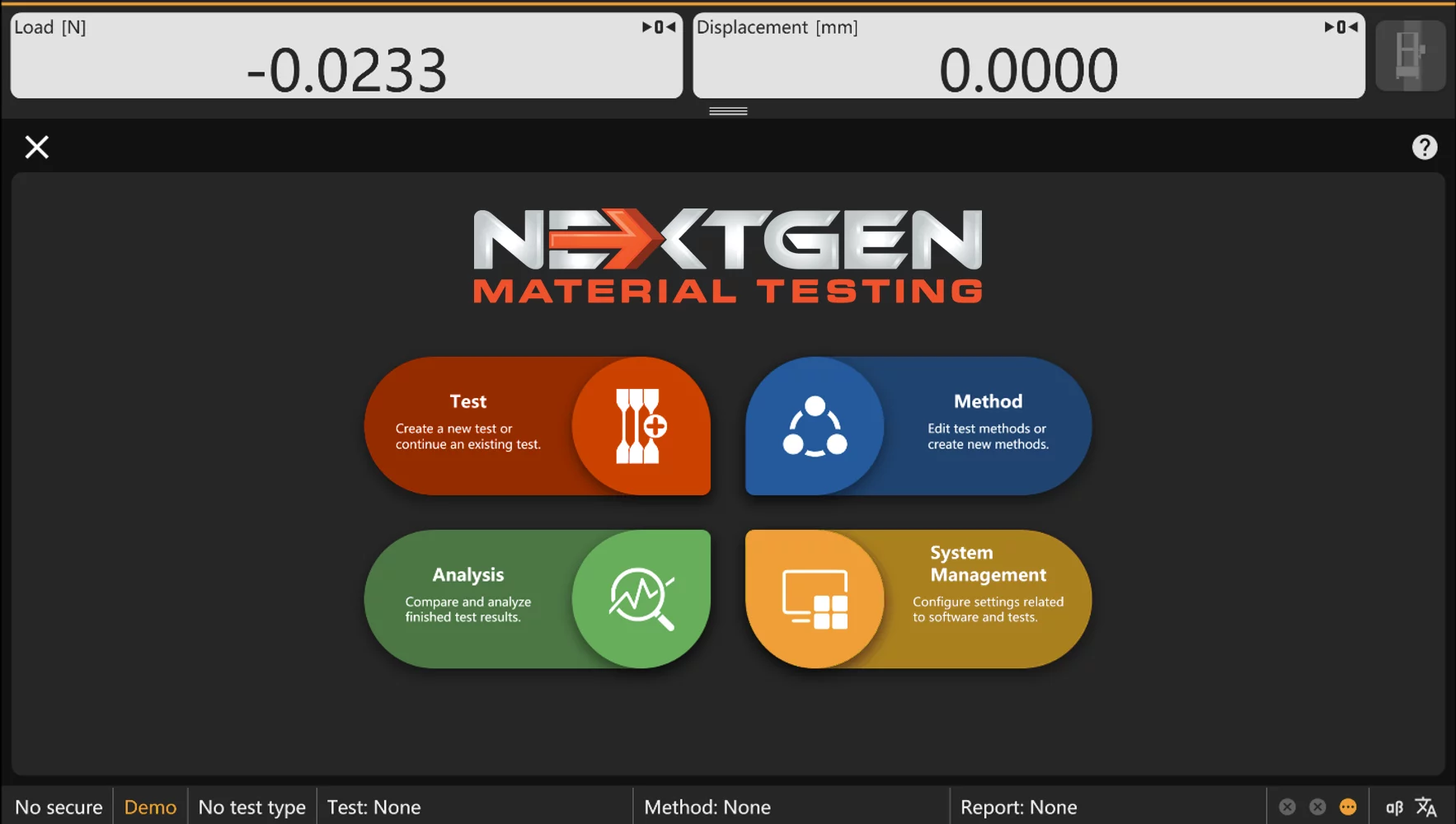
GenTest Data Acquisition Software - Advanced Universal Testing Machine Software
Upgrade to GenTest, the latest data acquisition software for universal testing machines. Ensure precise, repeatable material testing with an intuitive interface, powerful analysis tools, and full compliance with ASTM, ISO, DIN, and more.
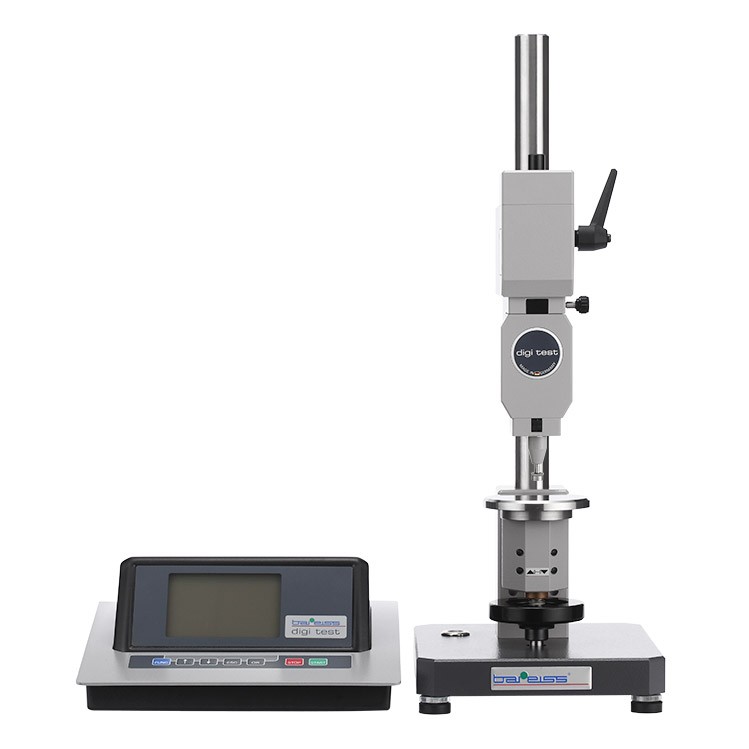
Automatic Shore, IRHD and VLRH Hardness Testing System
NextGen is proud to present our German line of fully-automatic Shore, IRHD and VLRH hardness testing system for plastic materials, plastic and foam compounds for the ultimate precision, accuracy and repeatability, exceptional ease-of-use and maintenance. Experience the industry leader for specimen testing including rubbers, plastics, foams, composites, o-rings, and more.
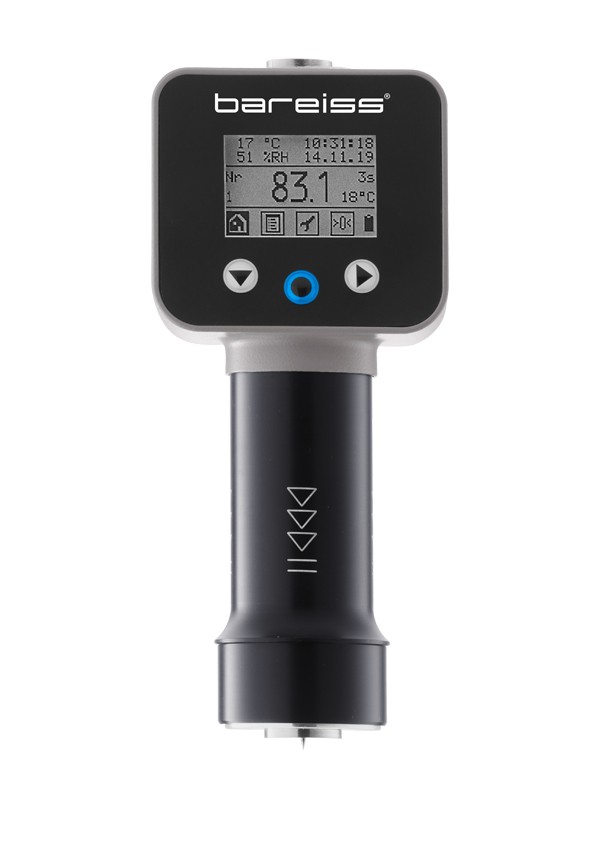
Advanced Portable Shore Durometer System with Test Stand Options
HPEIII is NextGen's advanced German line of equipment that is the new generation of HPE systems ideal for various plastic and plastic compound testing. The new system enhancements offer advantages including temperature sensor, reading values of ambient temperature and humidity, historical hardness value display, larger LCD display, standard USB connection and much more. These advanced portable systems can be paired up with either manual or automatic motorized test stands to help eliminate the human error factor and maximize accuracy and repeatability between test when switching from one operator to the next.
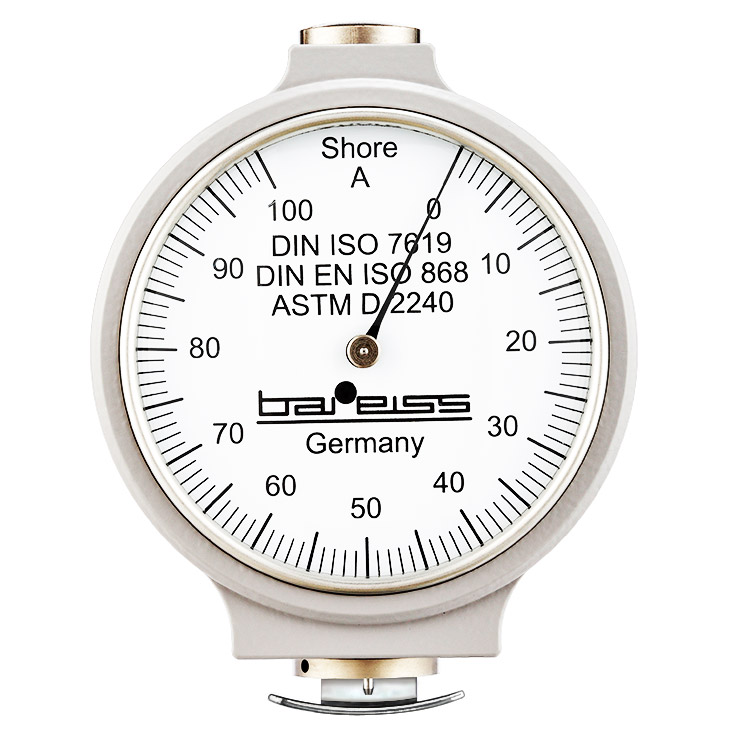
Classic Analogue Shore Durometer with Test Stand Options
This German-manufactured system has been the global benchmark of Shore hardness testing systems since 1954. With ever enhanced ergonomic design, the HP Shore Hardness Tester is both visually appealing and precise rubber and plastic testing system as it has been for nearly 50 years.
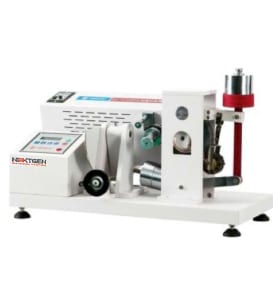
Akron Abrasion Tester
GenKron is used together with a special balance for testing the abrasive consumption of materials. The measurements are done through volumetric loss of a rotating specimen exposed to the action of a standard grinding wheel. It is especially suited for testing harder materials such as shoe soles, tires and other rubber materials.
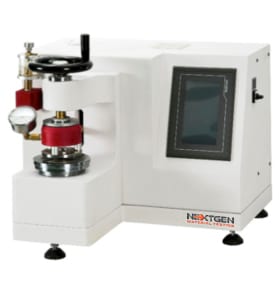
Burst Strength Tester for Fabric
GenBurst is the Burst Strength Tester designed to test anti-rupture strength of variety of materials such as leather, paper and fabric.
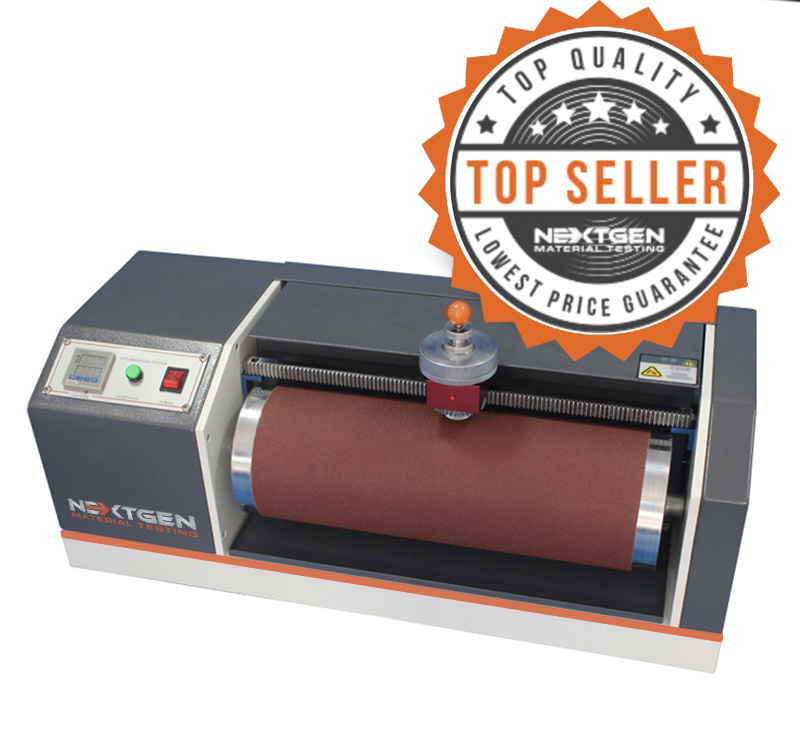
DIN Abrasion Tester
GenDin, is designed to conform to the ASTM D5963 and IS0 4649 standards. This top quality and highly popular abrasion tester will allow you to measure the abrasion resistance of rubbers (vulcanized thermo set rubbers and thermoplastic elastomers) that are subject to abrasive/frictional wear on their actual service. Since wear is always a result of abrasion, different test methods have been developed for the simulation of long term wear.
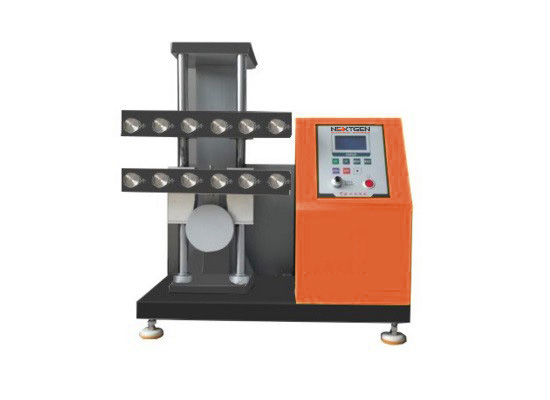
Demattia Flex Cracking Tester
GenFlex tests the ability of rubber products to withstand repeated flexing without developing cracks is of prime importance where such products are used in conditions undergoing repeated flexing. Flexing endurance of rubber products is determined by simulating in laboratory the action of flexing repeatedly under standard conditions of speed, mode, and degree of flexing.
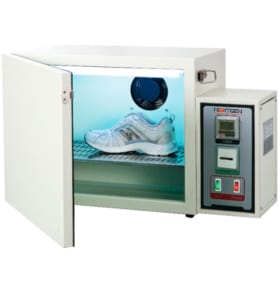
Discoloration Meter
The machine is used to simulate an environment of sunlight radiation on a specimen to identify the resistance of fabric to discoloration.
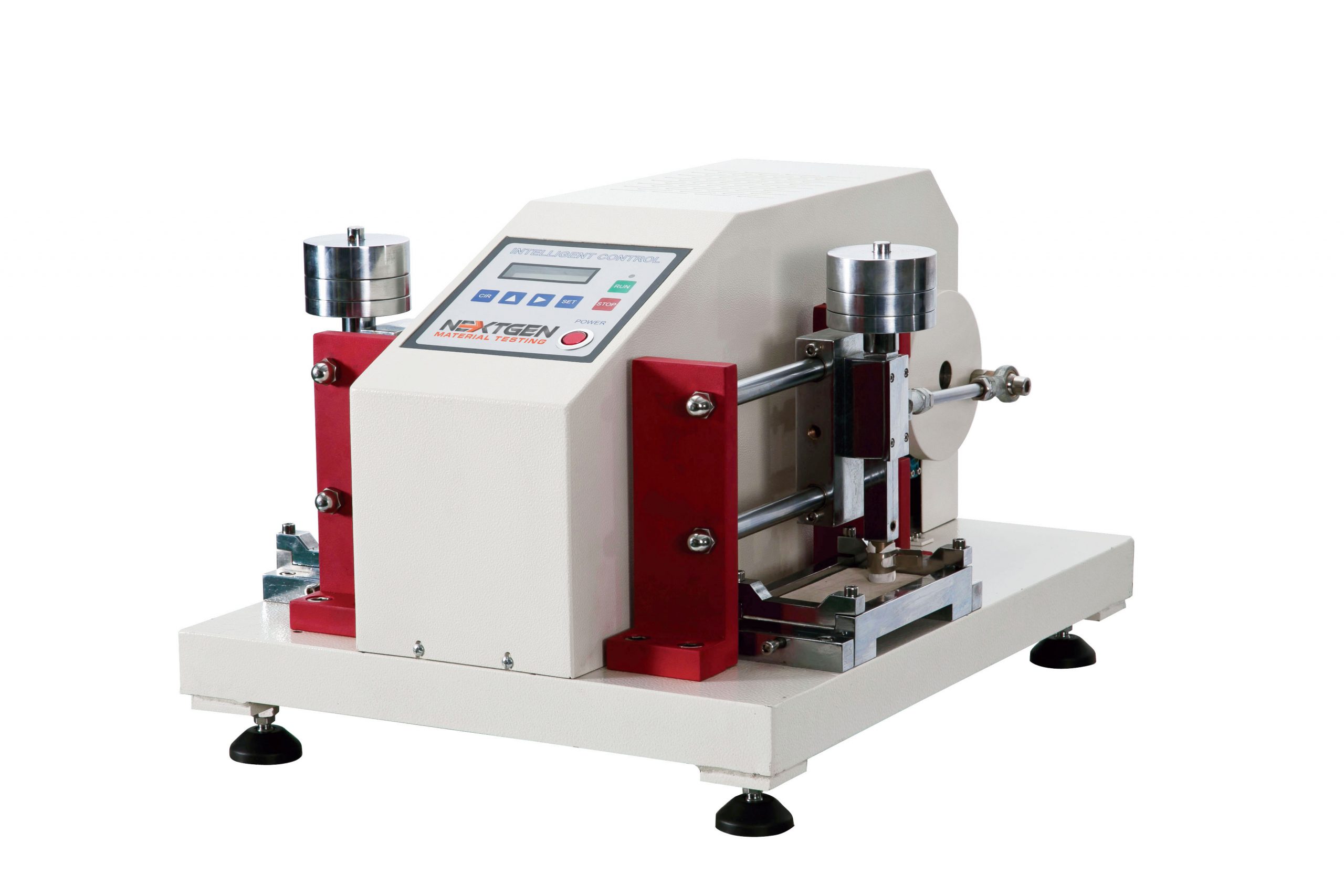
Electric Crocking Tester - GenCrock
The machine is used to test the dyeing of the fabric, and the fade degree of the leather after dry or wet rubbing. The test method involves the specimen to be fastened to the base of the crocking meter and rubbed with an abrasive hammer attached to a wet or a dry cloth under controlled conditions. The transfer of colour is then measured using a scale to evaluate the rating of the specimen's dyeing grade.
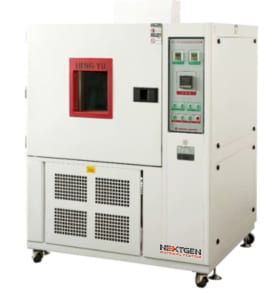
Freezing Tester - GenFreeze
GenFreeze is specially designed to test the characteristics of various materials in a cold environment to ensure suitability for use in a cold climate. Based on the testing demand, adjust the beater and flexing grip, then load to the desired position. It can be used to test rubbers, leather, and plastics, PU leather etc. The unit can be adjusted to meet different requirements.
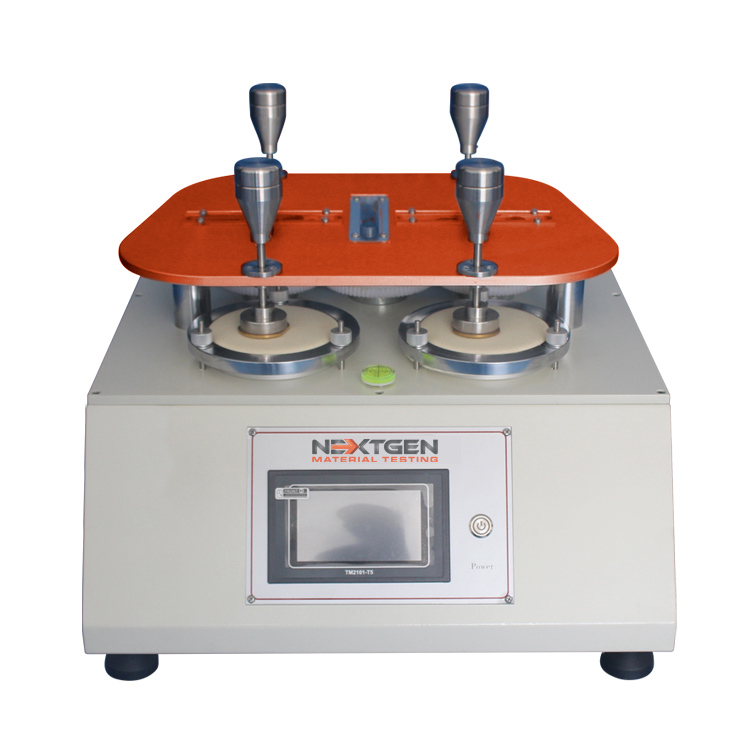
Martindale Abrasion Tester - GenDale
GenDale is mainly used to test shoe fabric, shoe lining, and many other types of shoe related materials. The unit can test up to four specimens at the same time for abrasion. The fabric specimen is measured by having rubbing applied on it via a complex direction of back and forth motion. The accuracy of abrasion strength is determined by the specific number of cycles conducted until a hole appears in the test area of the fabric specimen.
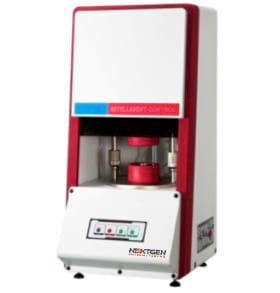
Mooney Viscosity Testing Machine - GenMooney
GenMooney is a viscosity testing machine is applied to measure the viscosity of the unmixed or mixed unvulcanized natural rubber, synthetic rubber and regenerated rubber .This tester has many functions such as fast warming, maintaining temperature, data stability, etc. It is equipped with an automated calibration feature for a simple data calibration of each experiment.
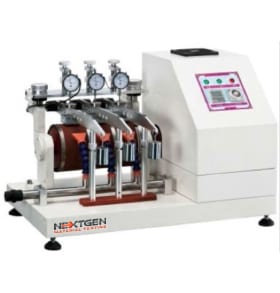
NBS Rubber Abrasion Tester - GenNBS
GenNBS is used to test the abrasion resistance of vulcanized rubber or other rubber compounds. It is commonly used for the soles and heels of footwear. It has an intelligent power failure recovery system. The unit conducts measurements through volumetric loss of specimens exposed to the action of a normalized abrasive medium secured to a rotations cylinder.
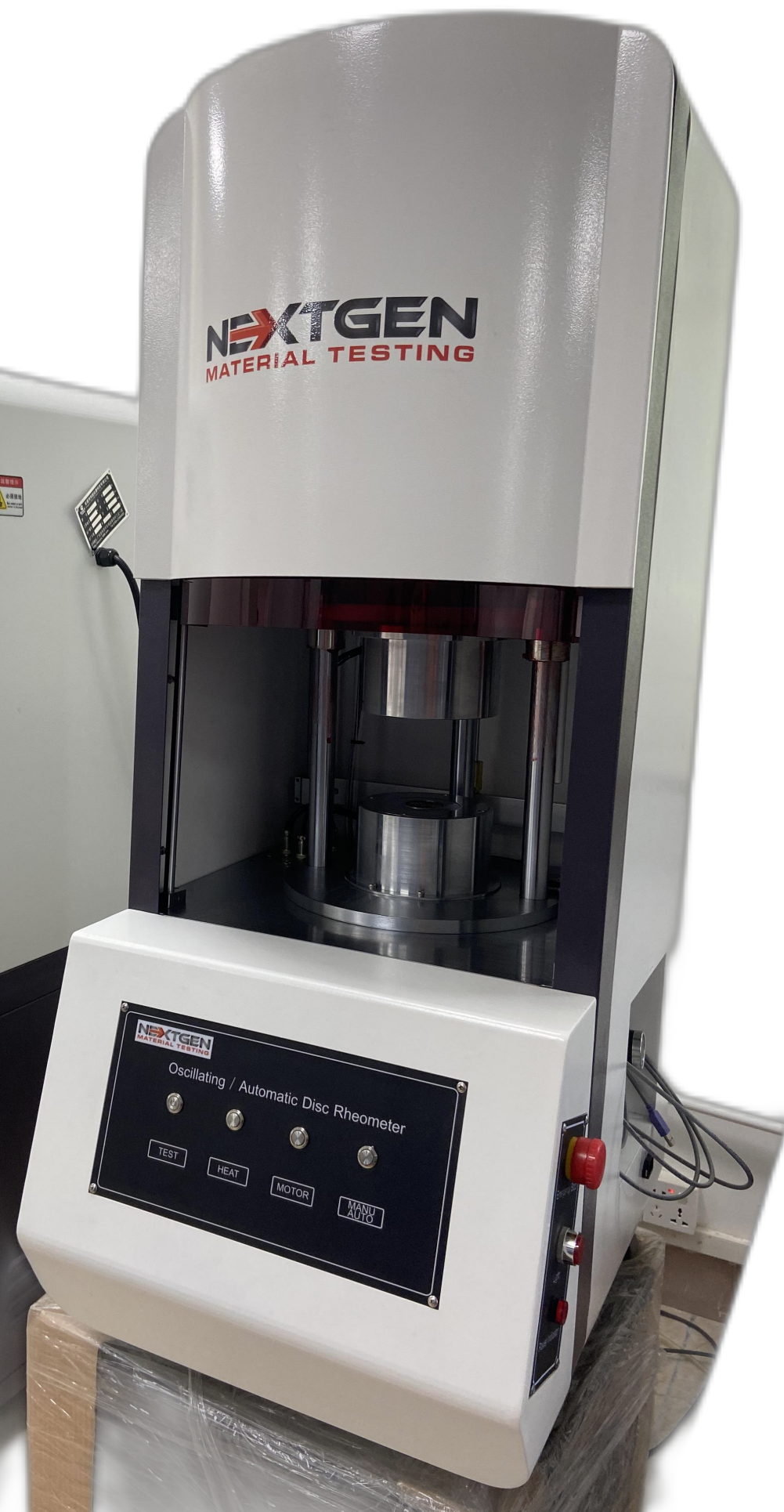
Oscillating / Automatic Disc Rheometer (ODR)
This machine is designed to get the characteristic curve and characteristic parameters of rubber vulcanization by measuring the applied moment of rubber to the oscillating dye body. NG-ODR rotor-free vulcameter has an excellent stability of results. The data and diagrams can be used as a reference for development, research and production quality.
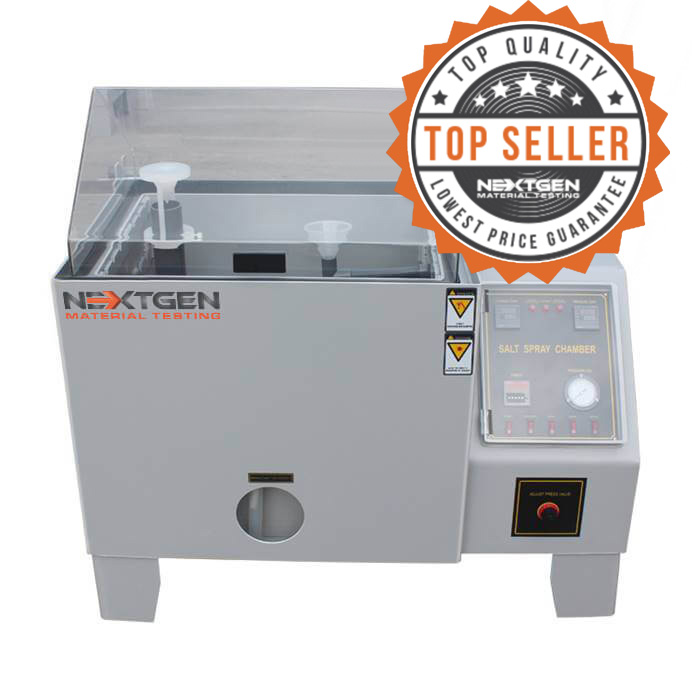
Salt Spray Tester - GenSalt
GenSalt is designed to test the surface of different materials for resistance to corrosion. The unit is commonly used to test coated materials of a metallic nature in a controlled corrosive environment. The test can be used on rust-proof painting, anodizing, electroplating and rust-proof of grease. The machine imitates expedited corrosion process via salt spraying on a given test sample to identify the corrosion (oxides) resistance. Test results are based on the longevity of time a material can resist visible corrosion on the test sample.
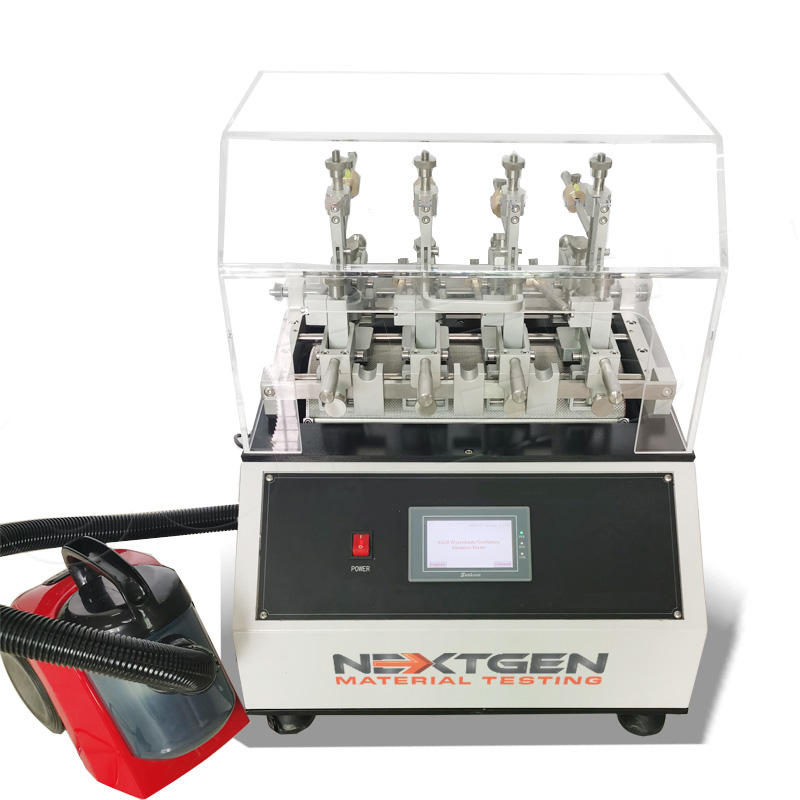
Wyzenbeek Abrasion Tester - GenWyze
The machine is designed to test the abrasion resistance of fabrics and metals. The abrasion of fabrics is tested when the specimen is pulled over the frame and rubbed against an abradant over a curved surface. The number of cycles, also known as double rubs, conducted on the specimen before the fabric shows visible wear is used to determine the rating of abrasion.

Vertical Rebound Resilience Tester - GenRebound
GenRebound tests the resilience of rubber compounds. The machine must be adjusted in a horizontal position and the plunger raised at a specific height. The plunger is then released onto the specimen for a given number of impacts. The measurements are based on the 4th, 5th, and 6th impacts. The average of the three (3) measurements is then calculated for the test result. The machine is highly useful in production of compounds designed to absorb vibration or shock according to the ASTM standards.
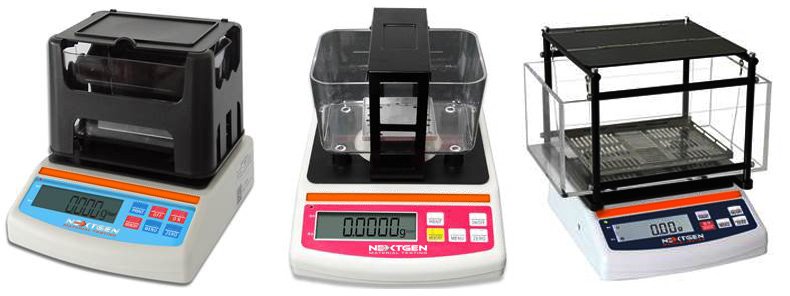
Digital Densimeter Systems
Description The NG-DM-A Series offers high-accuracy digital Densimeters designed for a wide variety of material testing needs. These elegant and compact densimeter systems offer capacity ranges from 150g to 3000g with accuracy of 0.001g/cm3 down to 0.0002g/cm3. Advanced Densimeter System […]
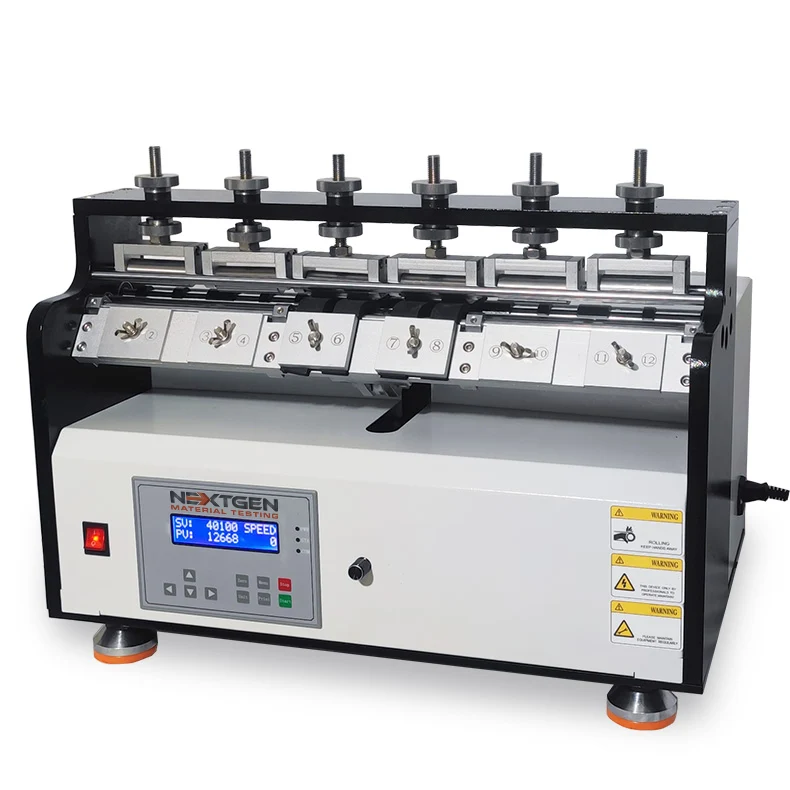
Ross Flex Tester
Ross Flex Tester is designed to determine the resistance of vulcanized or synthetic elastomers to cut growth. The system does so under continuously bend flexing in 90°.
